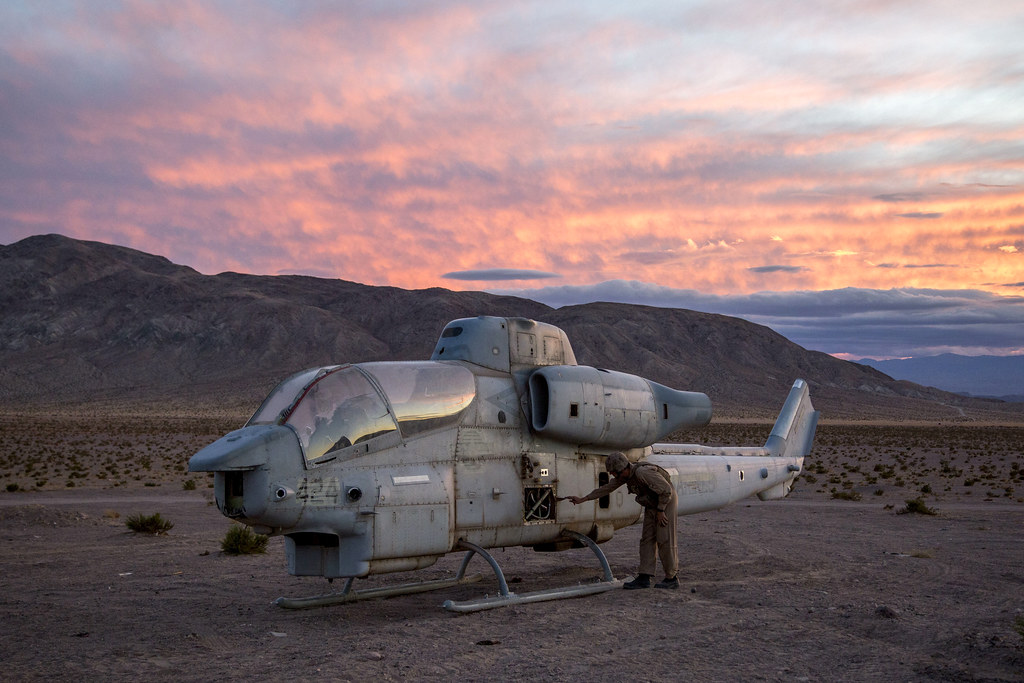#marine aircraft group 31
Text
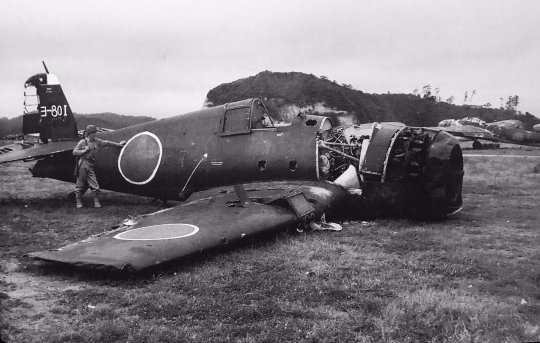
Chasseur Grumman F6F Hellcat aux couleurs japonaises retrouvé par un marine du Marine Aircraft Group 31 – Base aérienne navale de Yokosuka – Guerre du Pacifique – Japon – 8 septembre 1945
Photographe : Sergent C. R. McDade
©National Museum of the US Navy - 127-GW-1627-134955
Le Marine Air Group 31 a décollé d'Okinawa pour occuper la base aérienne de Yokosuka après la capitulation du Japon.
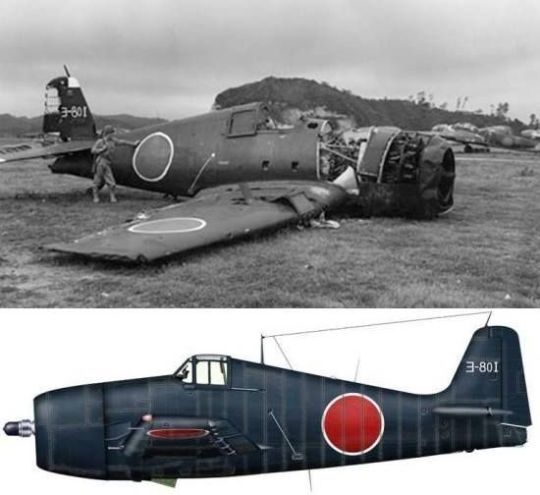
#WWII#guerre du pacifique#pacific war#occupation du japon#occupation of japan#united states marine corps#us marine corps#marine aircraft group 31#aviation militaire#military aviation#chasseur#avion de chasse#fighter#grumman f6f hellcat#f6f hellcat#hellcat#f6f#yokosuka#japon#japan#08/09/1945#09/1945#1945
40 notes
·
View notes
Text
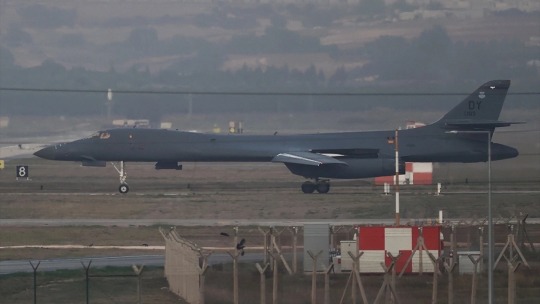
IMAGES: B-1 bombers make a historic visit to Turkey
Turkish Air Force integrates with U.S. bombers on a long-planned mission.
Fernando Valduga By Fernando Valduga 11/02/2023 - 12:56in Military
Two U.S. Air Force B-1B Lancers bombers assigned to the 9º Expeditionary Bomber Squadron arrived on Tuesday (10/31) at Incirlik Air Base, Turkey, for a historic hot-pit refueling as part of the long-planned bomber task force training mission.
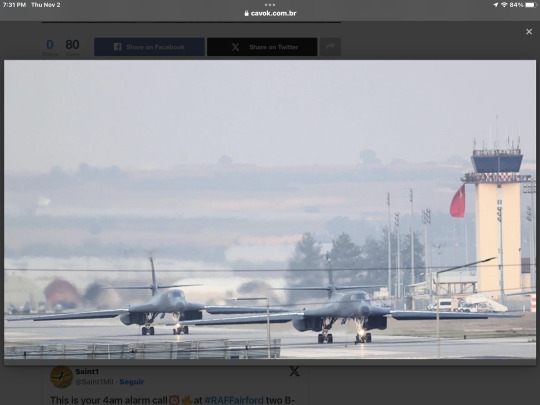
A hot-pit refueling refers to the tactic of refueling aircraft while the engines are still running. This marks the first time that U.S. Air Force B-1 has been replenished in this way at Incirlik Air Base. The aircraft stayed at the base for less than two hours before leaving for a training mission with the Turkish Air Force.
TAP TITLE BAR TO VIEW VIDEO ☝️
The Deputy Commander of the Wing of the 39ª Air Base, Colonel Robert Schoeneberg of the U.S. Air Force, and the Chief Command of the Wing of the 39ª Air Base, Chief Sergeant. Kevin Helms greeted the Commander of the 9º EBS, U.S. Air Force Colonel Lieutenant Ryan Stillwell, and the Sub-Commander of the 489º Bombing Group Command, U.S. Air Force Lieutenant Colonel Andrew Marshall on the flight line.

The B-1s integrated with the Turkish military, including the KC-135R Asena refuelers and the F-16 Fighting Falcons, for training missions planned well in advance to practice Joint Terminal Attack Controller (JTAC) procedures and close air support training missions.

“Teamwork with our Turkish air force partners has demonstrated the interoperability and professionalism of NATO aviators,” Stillwell said. “Thank you to the 10ª Tank Base and 39ª Wing Team Titan Air Base for their specialized support and hospitality.”

Incirlik Air Base is one of the largest military facilities in Turkey and its strategic location makes it a center for NATO integration and the defense of NATO's southern flank.

“We are excited to support and celebrate this historic refueling operation in Incirlik,” Schoeneberg said. "This demonstrates the unique capabilities and strategic positioning of this base. In addition, it highlights for everyone that Turkey is a critical member of the NATO alliance and that Team Titan is open to business."
Tags: Military AviationB-1B LancerNATO - North Atlantic Treaty OrganizationTAF - Turkish Air Force / Turkish Air Force
Sharing
tweet
Fernando Valduga
Fernando Valduga
Aviation photographer and pilot since 1992, has participated in several events and air operations, such as Cruzex, AirVenture, Dayton Airshow and FIDAE. He has work published in specialized aviation magazines in Brazil and abroad. Uses Canon equipment during his photographic work in the world of aviation.
Related news
MILITARY
IDF: More than 12,000 targets were attacked in Gaza
02/11/2023 - 10:48
MILITARY
Indian Navy retires its Il-38 Sea Dragon
01/11/2023 - 19:40
MILITARY
Sale of F-16 to Turkey is not yet completed, even with Sweden's entry into NATO continuing
01/11/2023 - 16:00
HELICOPTERS
Airbus naval unmanned air system is tested at sea from a French frigate
01/11/2023 - 14:00
ARMAMENTS
Pentagon plans to develop new variant of the B61 gravitational nuclear bomb
01/11/2023 - 11:00
MILITARY
India informs France of its decision to acquire 26 Rafale Marine jets
01/11/2023 - 09:00
12 notes
·
View notes
Video
Inspection Time by Marines
Via Flickr:
A Marine with Marine Wing Support Detachment 31 inspects an aircraft while conducting mission rehearsals for an aircraft salvage and recovery exercise during Integrated Training Exercise 1-18 aboard Marine Corps Air Ground Combat Center, Twentynine Palms, California, Nov. 7, 2017. (U.S. Marine Corps photo by Staff Sgt. Kowshon Ye)
#2nd Marine Aircraft Wing#2nd MAW#MAG-31#Marine Fighter Attack Squadron 115#Marine Aircraft Group 31#MCAGCC Twentynine Palms#ITX#Intergrated Training Exercise#Marine Corps Air Ground Combat C#California#United States#US
1 note
·
View note
Text
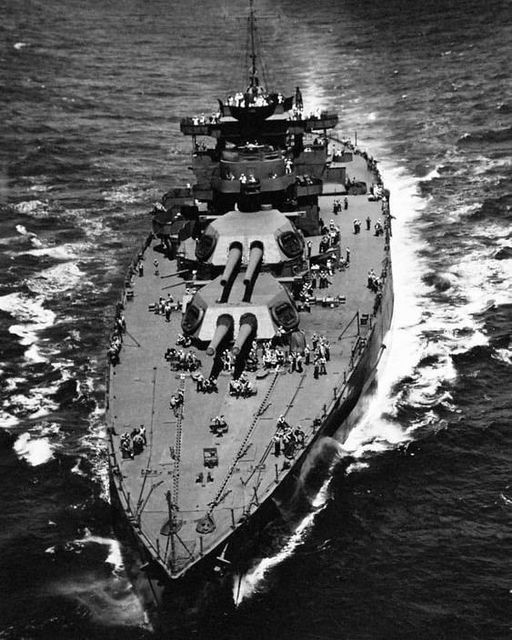
Battleship USS West Virginia underway in the Pacific, circa 1944. Severely damaged by Japanese torpedoes at Pearl Harbor, USS West Virginia returned to service in October 1944. When the Japanese surrendered on September 2, 1945, she was in Tokyo Bay, a symbol of the resilience of the United States Navy. By all accounts, she shouldn’t have been there. She had suffered damage beyond any expectations her designers had. But she was an American warship, a fulfillment of Alfred T. Mahan’s ideas of power projected around the world. Her salvage and repair were a feat of engineering and determination. A phoenix rises from the ashes, but USS West Virginia (BB-48) rose from the waters of Pearl Harbor to contribute to the defeat of the Japanese empire.
Pearl Harbor was shallow, and on December 7, 1941, West Virginia was moored outboard of USS Tennessee (BB-43) at Ford Island in 40 feet of water. As the Japanese attack began, West Virginia, her port side laid bare, became an easy target for enemy torpedoes. The first two struck simultaneously, at 7:55 a.m, as General Quarters sounded. Men poured from hatchways as she began to list. A third explosion rocked the battlewagon. Spotter planes atop main turrets were aflame when a massive explosion on USS Arizona (BB-39) sent chunks of steel flying into the air. Moored nearby, pieces as large as five inches rained down on West Virginia. Gun crews fired on approaching enemy aircraft, adding to the cacophony of the first day of a new war.
Torpedoes ripped into her hull below the waterline and bombs fell from enemy aircraft, one causing the sections of the superstructure to collapse. As fires broke out, the ship’s damage control parties fruitlessly attempted to extinguish them. All hands not severely wounded were at work, fighting fires, manning guns, or assisting with damage control. Up on the bridge, the ship’s commanding officer, Captain Mervyn S. Bennion, had been mortally wounded in the abdomen by an explosion. Mess Attendant second class Doris Miller helped pull sailors through oil and water, up to higher decks not awash as West Virginia began to settle on the bottom. Miller assisted with moving the wounded Bennion, and even though he’d had no instruction in the weapon’s use, manned a machine gun, firing at incoming Japanese planes.
Eventually the order to abandon ship was given. As the wounded were loaded into whaleboats and other small craft, others either crossed over to Tennessee, or dove into the oil-covered water, swimming to Ford Island. When the crew was finally accounted for, there were two officers, including her commanding officer Bennion, and 106 enlisted men killed. Numerous others were wounded, and some would need months to recover from the attack. West Virginia, known by her crews as “Wee Vee” would need much longer.
The damage inflicted in a matter of minutes took over two years to repair. To say the Japanese attack on Pearl Harbor on December 7, 1941, left West Virginia crippled is understating the true extent of the damage. In an official report of ships damage at Pearl Harbor, West Virginia hardly sounds worth repairing:
“West Virginia sank at her berth as a result of four or five aircraft torpedo hits and at least two bomb hits. The vessel rests on a hard bottom with all spaces flooded up to two or three feet below the main deck. Most of the damage from torpedoes is in the midship area, which is badly wrecked both below water and above water. A large bomb passed through the foretop and the boat deck and apparently exploded near the port side on the main or second deck. This explosion caused considerable wreckage and a terrific powder and oil fire, which burned out the whole area and extended to the foremast structure up to and including the bridge. A second bomb hit the top of turret III and passed through the 6-inch top. The nature of the penetration indicated defective material. This bomb did not explode but caused damage to the slide of the left gun. Recently another torpedo hole, and parts of the torpedo, have been located aft under the counter. The steering engine room appears to be wrecked and the rudder is lying on the bottom.” Her salvation was due to the actions of one man, which resulted in West Virginia remaining upright at her moorings, unlike USS Oklahoma (BB-37), which capsized. Lieutenant Commander John S. Harper, the damage control officer aboard West Virginia, quickly initiated counterflooding, keeping the battlewagon upright. As a result, West Virginia was found to be drawing 50 feet 6 inches forward, and 40 feet 10 inches aft, compared to her usual draft of approximately 30 feet. The midship area was considerably damaged, and the oil fire, which had burned for 30 hours, caused extensive damage to the upper works. The hull crinkled as the ship settled on the bottom, and one torpedo had knocked the rudder off. Despite the damage, the decision was made to salvage the ravaged ship, modernize her, and return her to service. Salvage was undertaken in several stages. Patches had to be placed on holes in the hull by divers. These patches were made as cofferdams, which were large wooden structures braced with steel and attached to the ship by divers. Special concrete that would harden in water was then poured into sections around the cofferdams, sealing the bottoms and making them watertight. With the major holes patched, 800,000 gallons of fuel oil, all projectiles and other supplies were removed from the ship to reduce weight. As water was pumped out of the ship, salvage crews began to work through compartments, removing the remains of 66 trapped sailors. Marks on a bulkhead in one compartment indicated three sailors survived there for 16 days. With access to food and water, they held on until the breathable air ran out.The work was done in earnest, performed by naval and civilian personnel and a skeleton crew of sailors and marines which remained attached to West Virginia. Specialists from various companies arrived in Pearl Harbor to break down and repair equipment such as electrical panels and the steam-driven turbine engines which powered West Virginia. Seventy tons of fresh meat had been aboard Wee Vee when she sank, all of which the crew removed via 10 gallon cans. Crews took care to wear rescue breathing apparatus or monitor the air quality as they cleaned compartments. Those containing large stores of paper were some of the most hazardous to empty, as the decaying paper gave off noxious gasses.
On May 17, 1942, West Virginia was once again floated. The first step in her recovery was done, and she was moved to Drydock #1 at Pearl on June 9. Her draft had improved to 33 feet, just barely allowing her to enter the drydock. There, repairs were made to the hull to make it watertight once again. Machinery and other equipment were removed and either repaired at Pearl or marked for later installation stateside. The oil residue left behind had to be removed from surfaces. At the time of the attack, West Virginia still had her original cage masts, both of which were removed in Pearl. Some guns were repaired so the ship could defend itself on the trip home. Crew spaces were cleaned up and returned to a usable state, and while the enlisted galley had burned, the officer’s galley was repaired and put to use for the entire crew. The ship was safely floated again after just three months, but work on the ship continued pier side until April 1943. On April 30, after more than a year of work on temporary repairs, West Virginia was stabilized, repaired, and ready to make the journey to Bremerton, Washington, for final repairs and outfitting.
In early July 1944, over two and a half years after the attack at Pearl Harbor, West Virginia began her sea trials from Puget Sound Navy Yard, Bremerton, Washington. She had been at the yard in Washington for over a year undergoing permanent repairs and modernization. The ship that took to the seas in July 1944 looked nothing like the old battlewagon that had been a target of the Japanese attack. Equipped with updated radar and fire-control equipment, she was ready to unleash the power of her 16-inch main battery on the enemy who had sidelined her years before.
Her first opportunity to exact her toll on Japanese forces came on October 19, 1944, as Wee Vee bombarded targets in Leyte, Philippines, flying the same flag which had been hoisted on that fateful Sunday in December. The next day, she covered landing forces there, providing fire as needed. What might be her crowning achievement came on October 25, when she participated in the battle of Surigao Strait. In what was to be the last engagement of battleships in history, West Virginia opened fire on an enemy ship, firing 16 salvos from her main battery. When the smoke cleared, the target was discovered to be the Japanese battleship Yamashiro, which sank in minutes. Though West Virginia’s captain let the crew claim credit, the damage had been inflicted by five battleships, plus cruisers, firing on the Japanese ship and making it a group effort which sank her.
After her triumphant engagement at Surigao, West Virginia continued her tear across the Pacific, supporting the landings at Mindoro, Luzon, Iwo Jima, and finally, Okinawa. After spending years in dry docks and shipyards, West Virginia put in 223 days in battle, where she shot down eight would-be Kamikazes and assisted with 12 others. Her number came up on April 1, 1945, when one successful Japanese pilot plowed his aircraft into Wee Vee, killing four sailors and wounding 23. But after Pearl, one enemy aircraft was akin to a mosquito bite, and she stayed in the action. On August 31, 1945, West Virginia steamed into Tokyo Bay. A Japanese harbor pilot had come aboard to navigate the battlewagon to her berth. Five members of the ship’s crew, all musicians, were transferred to USS Missouri (BB-63) to augment the band which would play at the official surrender ceremony.As the Japanese delegation boarded Missouri on September 2, West Virginia lay in harbor some distance away. She was the only survivor of the Pearl Harbor attack present in Tokyo Bay that morning. (The cruiser USS Detroit (CL-8), had also been present at Pearl, but received no damage.) As the most important ceremony of the war got underway, West Virginia had no role in the somber occasion. She lay silently, ghastly in the distance, a triumphant reminder of how Japan had gambled and lost.
38 notes
·
View notes
Text
Trump & the Military
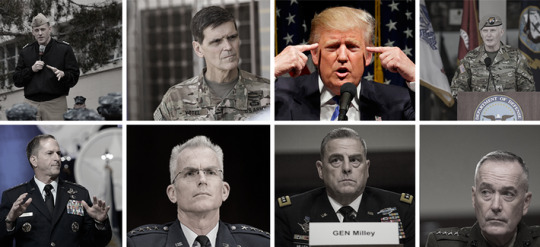
(This was shamelessly copy/pasted from OP on Reddit (u/myusernameiscool1234, thanks dude!) because it needs to be spread and I wanted to update a tad, add links and reformat it so it's easier to follow. I'm sure I'm missing stuff, so feel free to add to it and I'll try to update accordingly. Please Share!)
On Military Service
• Trump dodged the draft 5 times, 4 for college and 1 by having a doctor diagnose him with bone spurs.
• Trump said having unprotected sex was his own personal Vietnam (1998)
• Trump said “I felt that I was in the military in the true sense because I dealt with those people” because he went to a military-style academy and that he has “more training militarily than a lot of the guys that go into the military”. (2015 biography)
• Trump accepted a Purple Heart from a fan at one of his rallies and said: “I always wanted to get the Purple Heart. This was much easier.” (Aug 2, 2016)
• No Trump in America has ever served in the military; this spans 5 generations, and every branch of the family tree. In fact, the reason his grandfather immigrated to America was to avoid military service
• Trump made his 2nd wife, Marla Maples, sign a prenup that would have cut off all child support if Tiffany joined the military (reported on June 4th, 2019)
Use & Treatment of Military
• He sent commandos into an ambush due to a lack of intel, and sends contractors to pick them up, resulting in a commando being left behind, tortured, and executed. (Trump approved the mission because Bannon told him Obama didn’t have the guts to do it) (Oct 4, 2017)
• He forgot the aforementioned fallen soldier’s name during a call to his pregnant widow, then attacked her the next day (Oct 23-24, 2017)
• He urged Florida to not count deployed military votes (Nov 12, 2018)
• He used troops as a political prop by sending them on a phantom mission to the border and made them miss Thanksgiving with their families (Oct-Dec, 2018).
• He stopped using troops as a political prop immediately after the election. However, the troops remained in muddy camps on the border (Nov 7, 2018).
• He called troops on Thanksgiving and told them he’s most thankful for himself (Thanksgiving, 2018)
• He fired service members living with HIV just before the 2018 holidays (Dec 19, 2018-present)
• He finally visited troops 2 years after taking office, but only after 154 vacation days at his properties (Dec 26, 2018)
• Trump lied to deployed troops that he gave them a 10% raise. He didn’t give them a 10% raise (Dec 26, 2018). He initially tried to give the military a raise that was lower than the standard living adjustment. This was before Congress told him that idea wasn’t going to work. Then after giving them the raise that Congress made him, he lied about it pretending that it was larger than Obama’s. It wasn’t.
• He revealed a covert Seal Team 5 deployment , including names and faces, on Twitter during his visit to Iraq. Endangering both the operatives and their families. (Dec 26, 2018)
• He refused to sign his party’s funding bill, which shut down the government, and forced a branch of the military (see below) to go without pay. This branch of military was forced to work without pay, otherwise they would be AWOL. However, his appointees got a $ 10,000 pay raise (Dec 22, 2018 – Jan 25, 2019)
• He didn’t pay the Coast Guard, forcing service members to rely on food pantries (Jan 23, 2019)
• He denied female troops access to birth control to limit sexual activity (on-going. Published Jan 18, 2019)
• He banned service members from serving based on gender identity (Jan 22, 2019)
• He diverted military housing funds to pay for border wall (Feb 15, 2019). A judge subsequently denied this. In July 2019, SCOTUS ruled that Trump could in fact divert military housing funds to pay for his wall.
• Trump pardoned war criminals (May, 2019)
• In May 2019, Trump turned away US military from his Memorial Day speech because they were from the destroyer USS John S. McCain. Trump initially ordered the USS John McCain out of sight during his visit to Japan (May 15, 2019) which led to the ship’s name subsequently being covered. (May 27, 2019)
• In June 2019, Trump sent troops to the border to paint the fence for a better “aesthetic appearance” (June 7, 2019)
• Trump demanded US military chiefs stand next to him at 4th of July parade (reported July 2, 2019)
• Trump made the U.S. Navy Blue Angels violate ethics rules by having them fly at his July 4th political campaign (July 4, 2019)
• On July 31, 2019, Trump ordered the Navy rescind medals to prosecutors who were prosecuting war criminals.
• On October 8th, 2019, Trump plans to withdraw from Open Skies treaty giving Russia the ability to target our military aircraft.
Attacks on Service Members
• Trump said he doesn’t consider POWs heroes because they were caught. Says he "prefers people who were not caught" (July 18, 2015)
• He said he knows more about ISIS than American generals (Oct 2016)
• Trump attacks Gold Star families including: Myeshia Johnson — a gold star widow and the Khan family—gold star parents (2016-present)
• He called a retired general a ‘dog’ with a ‘big, dumb mouth’ (Jan 1, 2019)
• Well documented dislike of Sen. John McCain, going back to his statement on POWs (see above) and leading up to McCain’s passing. On March 20, 2019, Trump complained that deceased war hero, Sen. John McCain, didn’t thank him for his funeral.
• Trump started his D-Day commemoration speech by attacking a private citizen (Bette Midler, of all people) (reported on June 4th, 2019)
• Trump used his D-Day interview at a cemetery commemorating fallen US soldiers to attack Robert Muller, former FBI special counsel and a Vietnam veteran (June 6, 2019)
• Children of deployed US troops will no longer get automatic American citizenship if born overseas during deployment. This includes US troops posted abroad for years at a time (August 28, 2019)
• After he pleading with superiors in a letter asking to offload most of the sailors on the ship in order to allow for social distancing and sanitizing the USS Theodore Roosevelt, Trump attacks Capt. Crozier calling his letter “terrible” and "not appropriate” leading the Secretary of the Navy to remove Capt. Crozier from his post. 114 of 4,000 sailors on the ship had already tested po sitive for COVID-19. (April 3, 2020)
• On June 24, 2020, the White House ends the National Guard's deployments to assist the American people during the COVID-19 pandemic, the day before thousands of National Guard members would qualify for early retirement and education benefits under the Post-9/11 GI bill.
Immigrants in the military
• He deported veterans (2017-present)
• He ordered the discharge of active-duty immigrant troops with good records (2017-present)
• Trump doubled the rejection rate for veterans requesting family deportation protections (July 5, 2018)
• Trump deported active-duty spouses (11,800 military families face this problem as of April 2018).
• Trump deported a spouse of fallen Army soldier killed in Afghanistan, leaving their daughter parentless. The US has since overturned this as of April 16, 2019.
• In July 2019, Trump denied a United States Marine of 6 years entry into the United States for his scheduled citizenship interview (Reported July 17, 2019)
Treatment of Veterans
• For a decade, Trump sought to kick veterans off of Fifth Avenue because he found them unsightly nuisances outside of Trump Tower. Being quoted as saying, “While disabled veterans should be given every opportunity to earn a living, is it fair to do so to the detriment of the city as a whole or its tax paying citizens and businesses?” in 1991.
• Trump sent funds raised from a January 2016 veterans’ benefit to the Donald J Trump Foundation instead of veteran’s charities (Jan, 2016). The foundation has since been ordered shut because of fraud and Trump to pay $2 million in damages as of November 2019.
• The controversy surrounding wether or not he said vets get PTSD because they "aren’t strong" (Oct 3, 2016)
• He blocked a veteran group on Twitter (June 2017)
• Trump changed the GI Bill through his Forever GI Act.
• Trump changing the GI Bill caused the VA to miss veteran benefits, including housing allowances and forced many veterans to run out of food and rent. “You can count on us to serve, but we can’t count on the VA to make a deadline,” one veteran said. (reported October 7, 2018)
• While in Europe commemorating the end of WWI, he didn’t attend the ceremony at a US cemetery due to the rain – but other world leaders went anyway (Nov 10, 2018)
• He got three Mar-a-Lago guests to run the VA (unknown start – present, made well-known in 2018)
• He increased privatization of the VA, leading to longer waits and higher taxpayer cost (2018)
• He tried to slash disability and unemployment benefits for Veterans to $0, and eliminate the unemployability extrascheduler rating (Dec 17, 2018)
• He canceled an Arlington Cemetery visit on Veterans Day due to light rain (Nov 12, 2018)
• He tried to deport a marine vet who is a U.S.-born citizen (Jan 16, 2019). He deported countless other veterans (2017-present)
• When a man was caught swindling veterans’ pensions for high-interest “cash advances,” Trump’s Consumer Financial Protection Bureau fined him $1. As a reminder, the Trump administration’s goal was to dismantle the CFPB, installing Mick Mulvaney as the director, who publicly stated the bureau should be disbanded. (Jan 26, 2019)
• Trump purged 200,000 veterans’ healthcare applications (due to known administrative errors within VA’s enrollment process and enrollment system) (reported on May 13, 2019)
• On August 2, 2019, Trump requisitioned military retirement funds towards the border wall.
#politics#us politics#donald trump#trump#trump scandals#trump administration#fuck trump#anti trump#against trump#us military#military#us armed forces#armed services#us navy#us army#us marines#us special forces#us air force#navy#army#marines#special forces#air force#news#veteran#veterans benefits#veterans affairs#coast guard#us coast guard#national guard
720 notes
·
View notes
Video
Grumman F9F-2B Panther ‘123078 / A-112’ (NX9525A) by Alan Wilson
Via Flickr:
c/n K.93 Built 1949 for the US Navy with the Bureau No. 123078. She is airworthy and civil registered as NX9525A. She looks fantastic, although I don’t think she’s actually flown for a while. Cavanaugh Flight Museum, Addison Airport, Dallas, Texas. 25th October 2019 The following information on 150213 is from the museum’s excellent website:- “The Cavanaugh Flight Museum's Panther, Bureau No. 123078 was accepted by the United States Navy on October 21, 1949 and initially assigned to Fighter Squadron VF-31 at Naval Air Station (NAS) Quonset Pt. RI until 05/01/50. The next assignment was to Fleet Aircraft Service Squadron (FASRON) 2 also at NAS Quonset Point, until 05/12/50. The remainder of its assignments are as follows: VF-61 with Carrier Air Group (CVG) -6 at NAS Oceana VA, 5/50-8/50; VF-22 / CVG-6 at NAS Oceana VA, 08/50-04/51; Marine Fighter Squadron VMF-115 at Marine Corps Air Station (MCAS) Cherry Point, NC 04/51-8/51; Navy Bureau of Aeronautics (BuAer) for overhaul & repair (O&R) at NAS Norfolk VA 9/51-3/52; VF-72 at NAS Quonset Point RI, 03/52-4/52; BuAer at NAS Norfolk VA for O&R 4/52-5/52; On May 23, 1952, 123078 was transferred to Reserve Fighter Squadron VF-721, the "Starbusters". In August 1952, VF-721 was assigned to the aircraft carrier, USS Kearsarge (CV-33) which was deployed to waters off the Korean coast. During the months that followed, 123078 participated in over 30 combat missions attacking targets in North Korea. After receiving damage from anti-aircraft fire, 123078 was transferred to (FASRON) 11 for O&R. After repair, 123078 resumed combat operations with VF-91 aboard USS Philippine Sea (CV-47), 5/4/53-7/28/53 and subsequently VF-151 aboard USS Boxer (CV-21) 07/28/53-02/23/54. The Cavanaugh Flight Museum acquired 123078 in 1993 and put it through a 25,000 man hour restoration to restore it to its original flying condition. It was awarded the title "Grand Champion Warbird" at both the 1995 E.A.A. Sun-N-Fun Fly-In at Lakeland, FL and the 1995 E.A.A. Fly-In in Oshkosh WI. The Plane is painted in the colors and markings it wore when in service with Fighter Squadron VF-721 "Starbusters" during the Korean War”
15 notes
·
View notes
Link
The departure was sloppy, full of heartbreak and inadequate to many, including in particular the Afghan citizens who wanted to leave but were prevented from doing so, but departure is departure. We (the US and allies) have left, after two decades. I was reminded of the length of this when the media reported that one of the Marines killed at the airport was a baby when the war started. That is just plain wrong.
Excerpt from this Wall Street Journal story:
A U.S. military aircraft carried the last American troops out of Afghanistan on Monday, marking the formal end of the longest war in U.S. history but leaving hundreds of Americans and tens of thousands of Afghans to face a future of uncertainty and danger.
The final U.S. withdrawal came a day before the Aug. 31 deadline set by President Biden, an exit under the persistent threat of terrorist attacks that already had claimed the lives of 13 American service members and more than 200 Afghans, killed in a suspected Islamic State suicide bombing at the Kabul airport on Thursday.
Despite assurances to the contrary by Mr. Biden and other top administration officials, Americans and Afghan allies were left behind, though the State Department couldn’t provide precise figures.
The U.S. earlier Monday said it was working to assist hundreds of Americans still there. Advocacy groups said as many as 60,000 Afghan interpreters, drivers and others who assisted the U.S. military, CIA and U.S. diplomatic personnel over the years, along with their families, remain in the country, at risk of retribution from the Taliban.
The last flight of U.S. military personnel departed Afghanistan on Monday, just weeks shy of the 20th anniversary of what then-President George W. Bush called the first war of the 21st century.
In all, 2,461 U.S. troops were killed, including 13 in the past week, in a U.S. campaign that began Oct. 7, 2001, as an effort to topple the Taliban for harboring al Qaeda.
By U.S. government spending estimates, the war cost taxpayers $824.9 billion or, on average, $3.4 billion a month. Scholars such as those at Brown University’s Costs of War project estimate that the war’s total costs, like caring for more than 20,000 injured veterans, have already risen into the trillions.
2 notes
·
View notes
Text

Robert Charles Durman Mitchum (August 6, 1917 – July 1, 1997) was an American actor, director, author, poet, composer, and singer. Mitchum rose to prominence for starring roles in several classic films noirs, and his acting is generally considered a forerunner of the antiheroes prevalent in film during the 1950s and 1960s. His best-known films include Out of the Past (1947), The Night of the Hunter (1955), Cape Fear (1962), and El Dorado (1966). Mitchum was nominated for the Academy Award for Best Supporting Actor for The Story of G.I. Joe (1945). He is also known for his television role as U.S. Navy Captain Victor “Pug” Henry in the epic miniseries The Winds of War (1983) and sequel War and Remembrance (1988).
Mitchum is rated number 23 on the American Film Institute's list of the greatest male stars of Classic American Cinema.
Robert Mitchum was born in Bridgeport, Connecticut, on August 6, 1917, into a Norwegian-Irish Methodist family. His mother, Ann Harriet Gunderson, was a Norwegian immigrant and sea captain's daughter; his father, James Thomas Mitchum, was a shipyard and railroad worker of Irish descent.[3] His older sister, Annette (known as Julie Mitchum during her acting career), was born in 1914. Their father, James Mitchum, was crushed to death in a railyard accident in Charleston, South Carolina, in February 1919. Robert was one year old, and Annette was not yet five. Their mother was awarded a government pension, and soon realized she was pregnant. Her third child, John, was born in September of that year. Ann married again to Major Hugh Cunningham Morris, a former Royal Naval Reserve officer. Ann and Morris had a daughter together, Carol Morris, born July 1927, on the family farm in Delaware. When all of the children were old enough to attend school, Ann found employment as a linotype operator for the Bridgeport Post.
As a child, Mitchum was known as a prankster, often involved in fistfights and mischief. When he was 12, his mother sent him to live with her parents in Felton, Delaware; the boy was promptly expelled from middle school for scuffling with the principal. A year later, in 1930, he moved in with his older sister Annette, in New York's Hell's Kitchen. After being expelled from Haaren High School, he left his sister and traveled throughout the country, hopping on railroad cars, taking a number of jobs, including ditch-digging for the Civilian Conservation Corps and professional boxing. At age 14 in Savannah, Georgia, he said he was arrested for vagrancy and put on a local chain gang. By Mitchum's own account, he escaped and returned to his family in Delaware. During this time, while recovering from injuries that nearly cost him a leg, he met Dorothy Spence, whom he would later marry. He soon went back on the road, eventually "riding the rails" to California.
Mitchum arrived in Long Beach, California, in 1936, staying again with his sister, now going by the name of Julie. She had moved to the West Coast in the hope of acting in movies, and the rest of the Mitchum family soon joined them. During this time, Mitchum worked as a ghostwriter for astrologer Carroll Righter. Julie convinced him to join the local theater guild with her. At The Players Guild of Long Beach, Mitchum worked as a stagehand and occasional bit-player in company productions. He also wrote several short pieces which were performed by the guild. According to Lee Server's biography (Robert Mitchum: Baby, I Don't Care), Mitchum put his talent for poetry to work writing song lyrics and monologues for Julie's nightclub performances.
In 1940, he returned to Delaware to marry Dorothy Spence, and they moved back to California. He gave up his artistic pursuits at the birth of their first child James, nicknamed Josh, and two more children, Chris and Petrine, followed. Mitchum found steady employment as a machine operator during wartime era WWII, with the Lockheed Aircraft Corporation, but the noise of the machinery damaged his hearing. He also suffered a nervous breakdown (which resulted in temporary blindness), due to job-related stress. He then sought work as a film actor, performing initially as an extra and in small speaking parts. His agent got him an interview with Harry Sherman, the producer of Paramount's Hopalong Cassidy western film series, which starred William Boyd; Mitchum was hired to play minor villainous roles in several films in the series during 1942 and 1943. He went uncredited as a soldier in the Mickey Rooney 1943 film The Human Comedy. Also in 1943 he and Randolph Scott were soldiers in the Pacific Island war film Gung Ho.
Mitchum continued to find work as an extra and supporting actor in numerous productions for various studios. After impressing director Mervyn LeRoy during the making of Thirty Seconds Over Tokyo, Mitchum signed a seven-year contract with RKO Radio Pictures. He was groomed for B-Western stardom in a series of Zane Grey adaptations.
Following the moderately successful Western Nevada, RKO lent Mitchum to United Artists for The Story of G.I. Joe (1945). In the film, he portrayed war-weary officer Bill Walker (based on Captain Henry T. Waskow), who remains resolute despite the troubles he faces. The film, which followed the life of an ordinary soldier through the eyes of journalist Ernie Pyle (played by Burgess Meredith), became an instant critical and commercial success. Shortly after filming, Mitchum was drafted into the United States Army, serving at Fort MacArthur, California, as a medic. At the 1946 Academy Awards, The Story of G.I. Joe was nominated for four Oscars, including Mitchum's only nomination for Best Supporting Actor. He finished the year with a Western (West of the Pecos) and a story of returning Marine veterans (Till the End of Time), before filming in a genre that came to define Mitchum's career and screen persona: film noir.
Mitchum was initially known for his work in film noir. His first foray into the genre was a supporting role in the 1944 B-movie When Strangers Marry, about newlyweds and a New York City serial killer. Undercurrent, another of Mitchum's early noir films, featured him as a troubled, sensitive man entangled in the affairs of his brother (Robert Taylor) and his brother's suspicious wife (Katharine Hepburn). John Brahm's The Locket (1946) featured Mitchum as bitter ex-boyfriend to Laraine Day's femme fatale. Raoul Walsh's Pursued (1947) combined Western and noir styles, with Mitchum's character attempting to recall his past and find those responsible for killing his family. Crossfire (also 1947) featured Mitchum as a member of a group of World War II soldiers, one of whom kills a Jewish man. It featured themes of anti-Semitism and the failings of military training. The film, directed by Edward Dmytryk, earned five Academy Award nominations.
Following Crossfire, Mitchum starred in Out of the Past (also called Build My Gallows High), directed by Jacques Tourneur and featuring the cinematography of Nicholas Musuraca. Mitchum played Jeff Markham, a small-town gas-station owner and former investigator, whose unfinished business with gambler Whit Sterling (Kirk Douglas) and femme fatale Kathie Moffett (Jane Greer) comes back to haunt him.
On September 1, 1948, after a string of successful films for RKO, Mitchum and actress Lila Leeds were arrested for possession of marijuana.[10] The arrest was the result of a sting operation designed to capture other Hollywood partiers as well, but Mitchum and Leeds did not receive the tipoff. After serving a week at the county jail (he described the experience to a reporter as being "like Palm Springs, but without the riff-raff"), Mitchum spent 43 days (February 16 to March 30) at a Castaic, California, prison farm. Life photographers were permitted to take photos of him mopping up in his prison uniform. The arrest inspired the exploitation film She Shoulda Said No! (1949), which starred Leeds. The conviction was later overturned by the Los Angeles court and district attorney's office on January 31, 1951, after being exposed as a setup.
Despite, or because of, Mitchum's troubles with the law and his studio, his films released immediately after his arrest were box-office hits. Rachel and the Stranger (1948) featured Mitchum in a supporting role as a mountain man competing for the hand of Loretta Young, the indentured servant and wife of William Holden. In the film adaptation of John Steinbeck's novella The Red Pony (1949), he appeared as a trusted cowhand to a ranching family. He returned to film noir in The Big Steal (also 1949), where he reunited with Jane Greer in an early Don Siegel film.
In Where Danger Lives (1950), Mitchum played a doctor who comes between a mentally unbalanced Faith Domergue and cuckolded Claude Rains. The Racket was a noir remake of the early crime drama of the same name and featured Mitchum as a police captain fighting corruption in his precinct. The Josef von Sternberg film, Macao (1952), had Mitchum as a victim of mistaken identity at an exotic resort casino, playing opposite Jane Russell. Otto Preminger's Angel Face was the first of three collaborations between Mitchum and British stage actress Jean Simmons. In this film, she played an insane heiress who plans to use young ambulance driver Mitchum to kill for her.
Mitchum was fired from Blood Alley (1955), due to his conduct, reportedly having thrown the film's transportation manager into San Francisco Bay. According to Sam O'Steen's memoir Cut to the Chase, Mitchum showed up on-set after a night of drinking and tore apart a studio office when they did not have a car ready for him. Mitchum walked off the set of the third day of filming Blood Alley, claiming he could not work with the director. Because Mitchum was showing up late and behaving erratically, producer John Wayne, after failing to obtain Humphrey Bogart as a replacement, took over the role himself.
Following a series of conventional Westerns and films noirs, as well as the Marilyn Monroe vehicle River of No Return (1954), Mitchum appeared in Charles Laughton's only film as director: The Night of the Hunter (1955). Based on a novel by Davis Grubb, the thriller starred Mitchum as a monstrous criminal posing as a preacher to find money hidden by his cellmate in the cellmate's home. His performance as Reverend Harry Powell is considered by many to be one of the best of his career.[15][16] Stanley Kramer's melodrama Not as a Stranger, also released in 1955, was a box-office hit. The film starred Mitchum against type, as an idealistic young doctor, who marries an older nurse (Olivia de Havilland), only to question his morality many years later. However, the film was not well received, with most critics pointing out that Mitchum, Frank Sinatra, and Lee Marvin were all too old for their characters. Olivia de Havilland received top billing over Mitchum and Sinatra.
On March 8, 1955, Mitchum formed DRM (Dorothy and Robert Mitchum) Productions to produce five films for United Artists; four films were produced. The first film was Bandido (1956). Following a succession of average Westerns and the poorly received Foreign Intrigue (1956), Mitchum starred in the first of three films with Deborah Kerr. The John Huston war drama Heaven Knows, Mr. Allison, starred Mitchum as a Marine corporal shipwrecked on a Pacific Island with a nun, Sister Angela (Deborah Kerr), as his sole companion. In this character study, they struggle to resist the elements and the invading Japanese army. The film was nominated for two Academy Awards, including Best Actress and Best Adapted Screenplay. For his role, Mitchum was nominated for a BAFTA Award for Best Foreign Actor. In the WWII submarine classic The Enemy Below (1956), Mitchum gave a strong performance as U.S. Naval Lieutenant Commander Murrell, the captain of a U.S. Navy destroyer who matches wits with a German U-boat captain Curt Jurgens, who starred with Mitchum again in the legendary 1962 movie The Longest Day. The film won an Oscar for Special Effects.
Thunder Road (1958), the second DRM Production, was loosely based on an incident in which a driver transporting moonshine was said to have fatally crashed on Kingston Pike in Knoxville, Tennessee, somewhere between Bearden Hill and Morrell Road. According to Metro Pulse writer Jack Renfro, the incident occurred in 1952 and may have been witnessed by James Agee, who passed the story on to Mitchum. He starred in the movie, produced, co-wrote the screenplay, and is rumored to have directed much of the film. It costars his son James, as his on screen brother, in a role originally intended for Elvis Presley. Mitchum also co-wrote (with Don Raye) the theme song, "The Ballad of Thunder Road".
He returned to Mexico for The Wonderful Country (1959) and Ireland for A Terrible Beauty/The Night Fighters for the last of his DRM Productions.
Mitchum and Kerr reunited for the Fred Zinnemann film, The Sundowners (1960), where they played husband and wife struggling in Depression-era Australia. Opposite Mitchum, Kerr was nominated for yet another Academy Award for Best Actress, while the film was nominated for a total of five Oscars. Mitchum was awarded that year's National Board of Review award for Best Actor for his performance. The award also recognized his superior performance in the Vincente Minnelli Western drama Home from the Hill (also 1960). He was teamed with former leading ladies Kerr and Simmons, as well as Cary Grant, for the Stanley Donen comedy The Grass Is Greener the same year.
Mitchum's performance as the menacing rapist Max Cady in Cape Fear (1962) brought him further renown for playing cold, predatory characters. The 1960s were marked by a number of lesser films and missed opportunities. Among the films Mitchum passed on during the decade were John Huston's The Misfits (the last film of its stars Clark Gable and Marilyn Monroe), the Academy Award–winning Patton, and Dirty Harry. The most notable of his films in the decade included the war epics The Longest Day (1962) and Anzio (1968), the Shirley MacLaine comedy-musical What a Way to Go! (1964), and the Howard Hawks Western El Dorado (1967), a remake of Rio Bravo (1959), in which Mitchum took over Dean Martin's role of the drunk who comes to the aid of John Wayne. He teamed with Martin for the 1968 Western 5 Card Stud, playing a homicidal preacher.
One of the lesser-known aspects of Mitchum's career was his foray into music as a singer. Critic Greg Adams writes, "Unlike most celebrity vocalists, Robert Mitchum actually had musical talent." Mitchum's voice was often used instead of that of a professional singer when his character sang in his films. Notable productions featuring Mitchum's own singing voice included Rachel and the Stranger, River of No Return, and The Night of the Hunter. After hearing traditional calypso music and meeting artists such as Mighty Sparrow and Lord Invader while filming Heaven Knows, Mr. Allison in the Caribbean islands of Tobago, he recorded Calypso – is like so ... in March 1957. On the album, released through Capitol Records, he emulated the calypso sound and style, even adopting the style's unique pronunciations and slang. A year later, he recorded a song he had written for Thunder Road, titled "The Ballad of Thunder Road". The country-style song became a modest hit for Mitchum, reaching number 69 on the Billboard Pop Singles chart. The song was included as a bonus track on a successful reissue of Calypso ... and helped market the film to a wider audience.
Although Mitchum continued to use his singing voice in his film work, he waited until 1967 to record his follow-up record, That Man, Robert Mitchum, Sings. The album, released by Nashville-based Monument Records, took him further into country music, and featured songs similar to "The Ballad of Thunder Road". "Little Old Wine Drinker Me", the first single, was a top-10 hit at country radio, reaching number nine there, and crossed over onto mainstream radio, where it peaked at number 96. Its follow-up, "You Deserve Each Other", also charted on the Billboard Country Singles chart. He sang the title song to the Western Young Billy Young, made in 1969.
Mitchum made a departure from his typical screen persona with the 1970 David Lean film Ryan's Daughter, in which he starred as Charles Shaughnessy, a mild-mannered schoolmaster in World War I–era Ireland. At the time of filming, Mitchum was going through a personal crisis and planned to commit suicide. Aside from a personal crisis, his recent films had been critical and commercial flops. Screenwriter Robert Bolt told him that he could commit suicide after the film was finished and that he would personally pay for his burial. Though the film was nominated for four Academy Awards (winning two) and Mitchum was much publicized as a contender for a Best Actor nomination, he was not nominated. George C. Scott won the award for his performance in Patton, a project Mitchum had rejected for Ryan's Daughter.
The 1970s featured Mitchum in a number of well-received crime dramas. The Friends of Eddie Coyle (1973) had the actor playing an aging Boston hoodlum caught between the Feds and his criminal friends. Sydney Pollack's The Yakuza (1974) transplanted the typical film noir story arc to the Japanese underworld. He also appeared in 1976's Midway about an epic 1942 World War II battle. Mitchum's stint as an aging Philip Marlowe in the Raymond Chandler adaptation Farewell, My Lovely (1975) was sufficiently well received by audiences and critics for him to reprise the role in 1978's The Big Sleep.
In 1982, Mitchum played Coach Delaney in the film adaptation of playwright/actor Jason Miller's 1973 Pulitzer Prize-winning play That Championship Season.
At the premiere for That Championship Season, Mitchum, while intoxicated, assaulted a female reporter and threw a basketball that he was holding (a prop from the film) at a female photographer from Time magazine, injuring her neck and knocking out two of her teeth. She sued him for $30 million for damages. The suit eventually "cost him his salary from the film."
That Championship Season may have indirectly led to another debacle for Mitchum several months later. In a February 1983 Esquire interview, he made several racist, anti-Semitic and sexist statements, including, when asked if the Holocaust occurred, responded "so the Jews say." Following the widespread negative response, he apologized a month later, saying that his statements were "prankish" and "foreign to my principle." He claimed that the problem had begun when he recited a racist monologue from his role in That Championship Season, the writer believing the words to be his own. Mitchum, who claimed that he had only reluctantly agreed to the interview, then decided to "string... along" the writer with even more incendiary statements.
Mitchum expanded to television work with the 1983 miniseries The Winds of War. The big-budget Herman Wouk story aired on ABC, starring Mitchum as naval officer "Pug" Henry and Victoria Tennant as Pamela Tudsbury, and examined the events leading up to America's involvement in World War II. He returned to the role in 1988's War and Remembrance, which continued the story through the end of the war.
In 1984, Mitchum entered the Betty Ford Center in Palm Springs, California for treatment of a drinking problem.
He played George Hazard's father-in-law in the 1985 miniseries North and South, which also aired on ABC.
Mitchum starred opposite Wilford Brimley in the 1986 made-for-TV movie Thompson's Run. A hardened con (Mitchum), being transferred from a federal penitentiary to a Texas institution to finish a life sentence as a habitual criminal, is freed at gunpoint by his niece (played by Kathleen York). The cop (Brimley) who was transferring him, and has been the con's lifelong friend and adversary for over 30 years, vows to catch the twosome.
In 1987, Mitchum was the guest-host on Saturday Night Live, where he played private eye Philip Marlowe for the last time in the parody sketch, "Death Be Not Deadly". The show ran a short comedy film he made (written and directed by his daughter, Trina) called Out of Gas, a mock sequel to Out of the Past. (Jane Greer reprised her role from the original film.) He also was in Bill Murray's 1988 comedy film, Scrooged.
In 1991, Mitchum was given a lifetime achievement award from the National Board of Review of Motion Pictures, in the same year he received the Telegatto award and in 1992 the Cecil B. DeMille Award from the Golden Globe Awards.
Mitchum continued to act in films until the mid-1990s, such as in Jim Jarmusch's Dead Man, and he narrated the Western Tombstone. He also appeared, in contrast to his role as the antagonist in the original, as a protagonist police detective in Martin Scorsese's remake of Cape Fear, but the actor gradually slowed his workload. His last film appearance was a small but pivotal role in the television biopic, James Dean: Race with Destiny, playing Giant director George Stevens. His last starring role was in the 1995 Norwegian movie Pakten.
A lifelong heavy smoker, Mitchum died on July 1, 1997, in Santa Barbara, California, due to complications of lung cancer and emphysema. He was about five weeks shy of his 80th birthday. His body was cremated and his ashes scattered at sea, though there is a plot marker in the Odd Fellows Cemetery in Delaware. He was survived by his wife of 57 years, Dorothy Mitchum (May 2, 1919 – April 12, 2014, Santa Barbara, California, aged 94); his sons, actors James Mitchum and Christopher Mitchum; and his daughter, writer Petrine Day Mitchum. His grandchildren, Bentley Mitchum and Carrie Mitchum, are actors, as was his younger brother, John, who died in 2001. Another grandson, Kian, is a successful model.
Mitchum is regarded by some critics as one of the finest actors of the Golden Age of Hollywood. Roger Ebert called him "the soul of film noir." Mitchum, however, was self-effacing; in an interview with Barry Norman for the BBC about his contribution to cinema, Mitchum stopped Norman in mid flow and in his typical nonchalant style, said, "Look, I have two kinds of acting. One on a horse and one off a horse. That's it." He had also succeeded in annoying some of his fellow actors by voicing his puzzlement at those who viewed the profession as challenging and hard work. He is quoted as having said in the Barry Norman interview that acting was actually very simple and that his job was to "show up on time, know his lines, hit his marks, and go home". Mitchum had a habit of marking most of his appearances in the script with the letters "n.a.r.", which meant "no action required", which critic Dirk Baecker has construed as Mitchum's way of reminding himself to experience the world of the story without acting upon it.
AFI's 100 Years...100 Stars lists Mitchum as the 23rd-greatest male star of classic Hollywood cinema. AFI also recognized his performance as the menacing rapist Max Cady and Reverend Harry Powell as the 28th and 29th greatest screen villains, respectively, of all time as part of AFI's 100 Years...100 Heroes and Villains. He provided the voice of the famous American Beef Council commercials that touted "Beef ... it's what's for dinner", from 1992 until his death.
A "Mitchum's Steakhouse" is in Trappe, Maryland, where Mitchum and his family lived from 1959 to 1965.
#robert mitchum#classic hollywood#classic movie stars#golden age of hollywood#old hollywood#1940s hollywood#1950s hollywood#1960s hollywood#1970s hollywood#1980s hollywood#1990s hollywood#hollywood legend
18 notes
·
View notes
Text
Bataan and Corregidor 1941-42 - Part 1

Last Stand of the “Battered Ba%$$rds”
(This article is credited to Jason Weiser. Jason is a long-time wargamer with published works in the Journal of the Society of Twentieth Century Wargamers; Miniature Wargames Magazine; and Wargames, Strategy, and Soldier.)
At the start of the Pacific War, the Philippines became a central target for the Japanese, and the islands were turned into a battleground. The events that unfolded at Bataan and Corregidor during the Japanese assault is not only an important piece of World War II history, it provides an incredible framework for potential wargaming scenarios.
Over a series of three posts, we will look at Bataan and Corregidor in-depth, starting with the lead up to the Philippines’ conflict and ending with an understanding of how learning about these locations can help construct wargaming scenarios. It has also been fodder for several fine boardgames on the topic.
Part 1, The Forces Gather
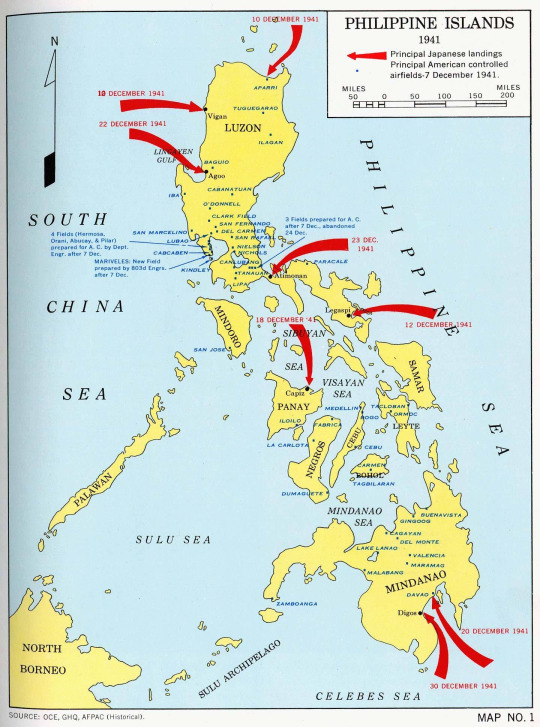
Author’s Note: Though both Philippine and American units fought in Bataan, I will refer to them as “American” collectively.
Most Americans aren’t familiar with names like Bataan and Corregidor. Like most historical topics in grade school, it’s quickly taught and forgotten by everyone, save for historical enthusiasts. In the Philippines, it’s akin to Bunker Hill, or Yorktown. To them, these places are where the modern Philippine nation was founded. Like many others, it was a nation bred on the battlefield.
The Philippines was in a unique state since 1898, when the United States had assumed control of the islands in the wake of the Spanish-American War. In 1935, the Philippines was made an American commonwealth, and a gradual process of making the islands ready for independence by 1946 was begun. To help form an independent Philippine armed forces, General Douglas McArthur was brought in by a Philippine government with the lofty rank of Field Marshal to try to modernize the defenses of the Philippines.
McArthur was seemingly a good choice for advising the nascent Philippine Republic, having served in the islands in his first assignment (1903-1906) after graduation from West Point while his father was Governor-General. He then spent time touring Japan (the future enemy of the Philippines) as his father’s aide de camp, and thus, had seen the Japanese soldier up close. Furthermore, Douglas McArthur and the president of the Philippines, Manuel Quezon, also had a personal relationship, as President Quezon had been friends with McArthur’s father during the latter’s time as Governor-General of the Philippines 35 years before. All of this made McArthur a shoo-in for the job of building a Philippine army.
There were also other incentives to McArthur taking the job. He had just concluded his term as Army Chief of Staff, and his relationship with the new Roosevelt administration was poor, at best (he had been involved in the suppression of the Bonus Marchers in 1932). Though McArthur completed his term in October of 1935, he probably hoped for a change of scenery. One of the assistants McArthur brought with him on this assignment was none other than Dwight D. Eisenhower.
What they found was an army that existed only on paper. Weapons were cast-offs from U.S. service and were of dubious provenance. The first class of trainees wasn’t due for another two years, and the camps to train them hadn’t been built either. And the budget to accomplish all of this was paltry at best. The Philippine Army lacked basics, like uniforms and even boots, with many divisions having to make do with the despised blue denim uniforms that had just been put out of U.S. service. The Navy and Air Corps weren’t doing much better, with the latter only forming their first squadron in 1939.
Worse, the level of training of the Army was poor, with one source stating:
“The men in the 31st Infantry [Division] were more fortunate than those in other regiments, many of whom had never even fired a rifle before entering combat. Nor had their previous five and a half months training under Philippine Army supervision been of much value…Practically none of the men…had fired as many as five rounds with the rifle or the .30 -caliber machine gun. None had fired the .50 caliber machine gun or the mortar.” (pp 29. The Fall of the Philippines, Morton, Lewis, US Army Center for Military History, Washington DC, 1953)
Contrast this with his Japanese opponent, who was most likely a veteran of the ten-year war in China, and was, supply deficiencies aside, well-trained and more than willing to come to grips with his opponent. The Philippine soldier was not ready for war, but war would be thrust upon him anyhow. This wasn’t true of all Filipino soldiers, as the Philippine Scouts, who numbered 12,000, were considered some of the best troops in the pre-war U.S. Army and were relatively well-equipped. However, they were under direct American command, and not under the command of the Philippine Army.
The U.S. troops in the islands themselves numbered 31,095 on the eve of war, and they had their own deficiencies. Funds were short for many years, and until September 1941, no reinforcements had arrived from the United States.
In September, the 200th Coast Artillery Regiment (Anti-Aircraft) arrived, bringing much needed additional anti-aircraft guns. In October, two tank battalions, the 192nd and the 194th, arrived in the islands, with 108 M3 Light Tanks between them, both units were soon formed into a Provisional Tank Group.
In addition, more P-40s and B-17s arrived to reinforce the U.S. Army Air Corps (USAAC) squadrons deployed throughout the islands. These were some of the most modern aircraft in the USAAC at the time, so this was meant as a deterrent to Japan and a signal that the United States was making a major investment in defense of the islands. At the outbreak of war, there were 277 USAAC aircraft of all types in the Philippines, most either at Clark or Nichols Fields on the main island of Luzon. There was also the construction of additional airfields, and many of them were built just in time. However, early warning capabilities against Japanese air attacks were woefully inadequate, and this would come back to haunt the Americans. For example, of the seven radar sets present in the islands, only two had been set up and were working.
Meanwhile, the naval presence in the islands was reliant on the U.S. and consisted of the Asiatic Fleet under Admiral Thomas Hart. His force was more to protect American commercial interests in China and “show the flag” rather than be any real impediment to Japanese aggression. The heaviest he had available was the heavy cruiser Houston, and most of the ships he had were of World War I vintage. His air arm consisted of some PBY patrol aircraft, which were useful, and he had at his disposal the 4th Marine Regiment in Shanghai at the beginning of 1941, but the regiment evacuated to the Philippines in late-November. Hart’s hope was that he could rely on support either from the British, or the Dutch, who had larger fleets in Southeast Asia, or the Pacific Fleet in Hawaii. All of these hopes were, of course, to be cruelly dashed when war came. The only ships Hart had in abundance were submarines, having 29 available as of November 1941. However, American torpedo design did little to help these submarines, as the standard Mark 14 torpedo had a high dud rate, and often, American subs were frustrated in the early part of the war in sinking targets they would have otherwise destroyed had they had better torpedoes.
In March 1941, McArthur was recalled to the U.S. Army and was placed in command of all American forces in the Philippines. Despite assurances and little to work with, McArthur had put together a force of 100,000 men to defend the Philippines. But the force still had many deficiencies, and not all of them, despite efforts on both sides of the Pacific to address them, were rectified in time. Many of these deficiencies would haunt the defenders of Bataan in the months to come.
Japanese Forces and Plans

The Japanese invasion plan for the Philippines was part of an even larger strategy that had been arrived at by the Imperial General Headquarters. It had been derived from separate Army and Navy plans, which had differed little in content. The strategic goal was simple: Seize Malaya for its rubber, the Dutch East Indies (Indonesia) for its oil, and expand a defensive perimeter as far out as possible to ensure that any attempt to push the Japanese back was a bloody one, and the Americans and British would prefer a negotiated peace to a long, intractable war. Many of the planned assaults were scheduled to occur within hours of the attack on Pearl Harbor.
The Philippines was an objective for two reasons. First, it was a linchpin in the sea lines of communication (SLOC) with the proposed advance into the Dutch East Indies and Malaya. The islands needed to fall to ensure the Japanese had a secure rear area. Secondly, Manila harbor was, and still is, one of the finest deep-water ports in Southeast Asia. The Japanese needed access to that as well to sustain their advance to the south.
The plan as it stood was for simultaneous air attacks on all American installations within hours of the attack on Pearl Harbor. While this was going on, the Japanese 14th Army was to land along the north coast of Luzon and at Davao on the island of Mindanao. Both islands were the most populated in the Philippine chain. The initial objective was to seize airfields to allow the Japanese Army Air Force to provide direct air support to the forces ashore. Once the main part of the USAAC strength was wiped out, the bulk of the 14th Army was to land in Lingayen Gulf just north of Manila and Limon Bay, southeast of Manila. The two prongs of advance were then to advance quickly to Manila, trap the Americans between them, and destroy the enemy in a decisive battle somewhere near Manila. The 14th Army, under the command of General Masaharu Homma, had been given 50 days to complete this task, whereupon half of his command and most of his air support would leave to support operations to the south. As we shall see, the Japanese came nowhere close to meeting this ambitious timetable.
The Japanese planning and information gathering had been meticulous, and they had a very good idea what they would be facing in the Philippines. The Japanese were of the opinion that Americans were good soldiers, but not up to the task of prolonged combat in the tropical jungles that made up a good portion of Luzon. Additionally, Japan did not think much of the Philippine soldier at all.
The main flaw in the Japanese invasion planning was they expected the American force would make its last stand around Manila, and then die in place. The Japanese had no plan for any contingency where the Americans withdrew into Bataan and fortified the peninsula.
As the Japanese expected a relatively easy campaign, they only allotted two divisions, the 16th and 48th Infantry Divisions. It was this over-confidence and optimistic planning that would cost them dearly in the campaign to come.
To be continued in Part 2 – The Curtain Rises – War Comes to the Philippines
At SJR Research, we specialize in creating compelling narratives and provide research to give your game the kind of details that engage your players and create a resonant world they want to spend time in. If you are interested in learning more about our gaming research services, you can browse SJR Research’s service on our site at SJR Research.
2 notes
·
View notes
Text

IMAGES: USA, South Korea and Australia start large-scale exercise with more than 130 aircraft
Fernando Valduga By Fernando Valduga 10/31/2023 - 08:23am Military, War Zones
More than 130 aircraft from the U.S., South Korea and Australia are participating in a joint exercise called "Vigilant Defense 24", which began on October 30.
Organized by the Seventh Air Force at Osan Air Base in South Korea, the exercise will last until November 3, focusing on interoperability between allies and a wide range of mission sets.


More than 25 types of aircraft are participating, including fighters, transport planes, tanker planes and reconnaissance planes, according to a statement from the Ministry of National Defense of the Republic of Korea.
The U.S. Air Force will contribute F-35, F-16 and A-10 combat/attack aircraft, as well as KC-135 air refuelers. The Air Force of the Republic of Korea will fly with its own F-35, as well as its E-7 for early warning and air control and the KC-330. The Royal Australian Air Force will contribute to KC-30A transport and refueling aircraft.


Colonel Michael G. McCarthy, commander of the 8º USAF Operations Group, said in a statement that opportunities like these are “truly invaluable to refine the necessary tactics, techniques and procedures that ensure that the combined force can operate as a cohesive unit, if we are called upon to do so.”
The statement of the 8ª Hunting Wing pointed out that the training exercise is routine, "of a totally defensive nature", and not in response to current threats or real-world situations.
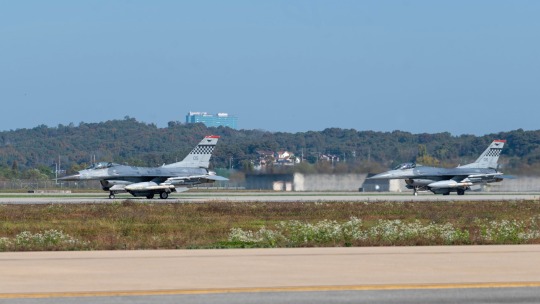

During the five-day event, the U.S. and South Korea will practice the integration of different types of aircraft and different types of operations, including air defense, close air support and emergency air interdiction, according to the ROK Ministry of National Defense.
Another goal will be to improve interoperability and coordination between fourth- and fifth-generation fighters. South Korea has already ordered and started receiving 40 fifth-generation F-35 fighters and intends to buy 25 more in a deal valued at $5.06 billion, which was approved by the U.S. Department of State in September.
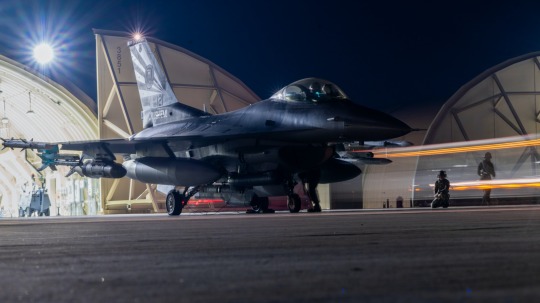
The joint training between the three allies brings the possibility of provoking a North Korean response. Last year's exercise, called 'Watchy Storm', featured about 240 aircraft from the U.S. Air Force, Marine Corps, Navy and Army, along with South Korea and Australia.
North Korea opposed the exercise through its state media. During and after last year's prolonged exercise, Pyongyang tested several short-range ballistic missiles and attempted to launch an intercontinental ballistic missile, which ended in a failure.
The leaders of the U.S. and South Korea have committed to conducting more regular and large-scale exercises together to strengthen the alliance and dissuade North Korea.
North Korea, however, continues to test new missiles. More recently, it fired two short-range ballistic missiles before a bilateral meeting between leader Kim Jong Un and Russian President Vladimir Putin on September 13.

After this meeting, the U.S., South Korea and Japan criticized North Korea for providing military equipment to Russia against Ukraine, warning that such actions violate UN Security Council resolutions and could “significantly increase the human cost of Russia's war of aggression”.
The joint statement released on October 25 by U.S. Secretary of State Anthon Blinken and the foreign ministers of South Korea and Japan stated that Pyongyang is seeking military assistance from Moscow to develop its own capabilities. It also raised concerns about potential exchanges of nuclear or ballistic missile technology between them.

Russia and North Korea denied such exchanges, but satellite images and evaluation by think tanks indicate an increase in rail traffic and suspicions of ammunition shipments from Pyongyang to Moscow.
Tags: Military AviationJoint ExercisesRAAF - Royal Australian Air Force/Royal Australian Air ForceROKAF - Republic of Korea Air Force/South Korea Air ForceUSAF - United States Air Force / U.S. Air ForceWar Zones - Korean Peninsula
Sharing
tweet
Fernando Valduga
Fernando Valduga
Aviation photographer and pilot since 1992, has participated in several events and air operations, such as Cruzex, AirVenture, Dayton Airshow and FIDAE. He has work published in specialized aviation magazines in Brazil and abroad. Uses Canon equipment during his photographic work in the world of aviation.
Related news
MILITARY
Russian Su-57 fighter gets new compact air-to-air missile with a range of 300 km
31/10/2023 - 08:42
AERONAUTICAL ACCIDENTS
FAB C-98 Caravan aircraft makes emergency landing in river in the state of Roraima
30/10/2023 - 22:42
HELICOPTERS
British Army retires its Gazelle helicopters
10/30/2023 - 7:35 PM
HELICOPTERS
Nigerian Defense Delegation examines first T129 ATAK helicopter in Turkey
30/10/2023 - 16:00
MILITARY
Iranian army demonstrates new kamikazes drones with 1 kg warhead
10/30/2023 - 2:00 PM
HELICOPTERS
Spanish Navy receives first Airbus H135 helicopter
10/30/2023 - 11:00
8 notes
·
View notes
Text
Lucky 13



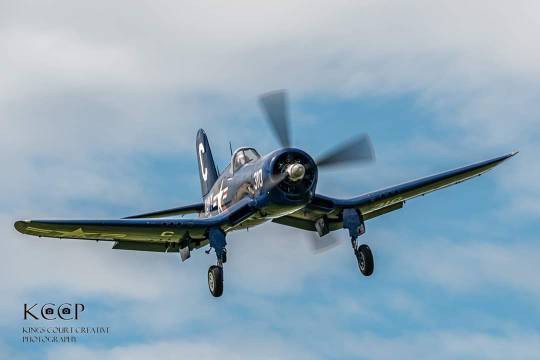
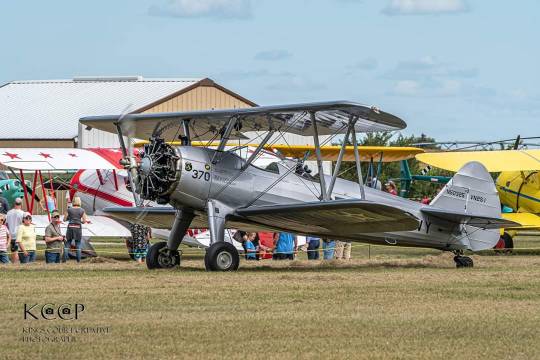
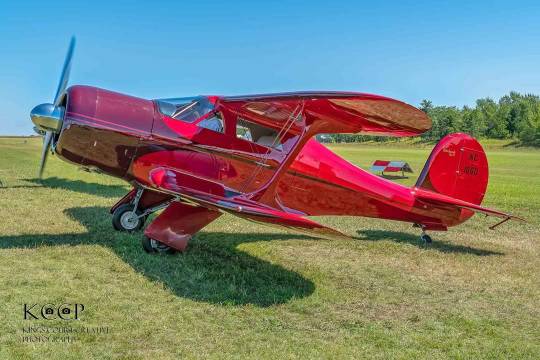
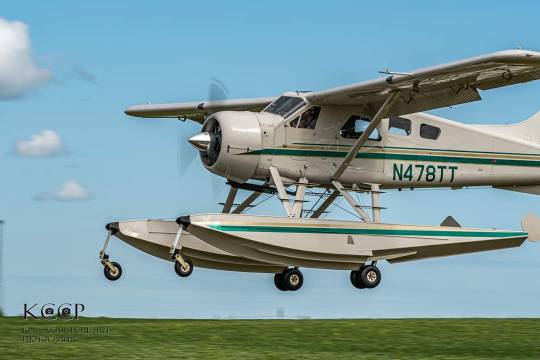
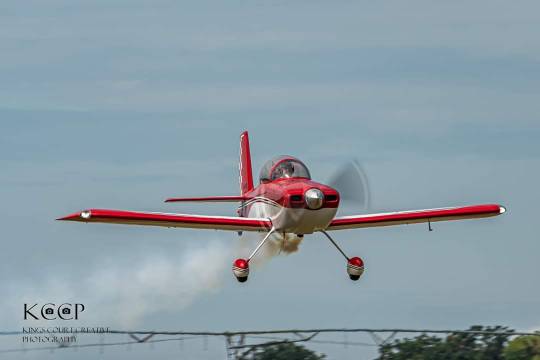
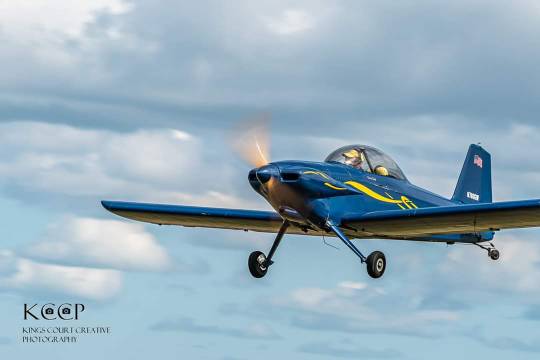
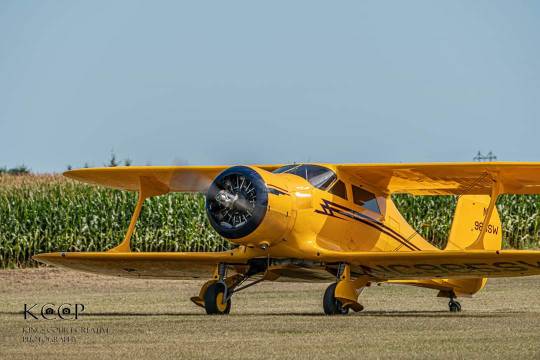
August 31, 2019
Thirteen is not usually considered a lucky number, unless you are an aviation buff, and you are attending the 13th annual Battle Lake Gathering of Airplanes (BLGA) at the Battle Lake Airport, in Battle Lake, Minnesota (Identifier 00MN) also known as the Tribute to Gerry Beck.
I’ve attended and photographed many fly-in’s and airshows, and this is both of those, but it takes place at a small grass airstrip in the lake’s country of western central Minnesota and has grown into a pretty spectacular event. The BLGA is held every Labor Day weekend on Saturday from 10AM until 2 PM to commemorate the renowned warbird rebuilder, Gerald “Gerry” Beck, known to most of his friends and even his wife Cindy, and daughter Whitney as “Beck”.
This was my second year attending and photographing this event and it was an amazing experience once again.
The 2019 Fly-in was the largest of the 13 yearly events so far, according to Patricia “Pat” Kostelecky the coordinator of the event. There were 82 aircraft and at least 500 people, attended including many who are heavily involved with war bird rebuilding and restoration, such as Casey Odegaard of Odegaard Aviation and the Fargo Air Museum, Warren Pietsch of the Dakota Territories Air Museum in Minot, ND, Ron Fagen of Fagen Fighters Museum in Granite Falls, MN, all must see locations if you like old war birds.
The initial Battle Lake Gathering of Airplanes, 14 years ago, had 10 people and 3 airplanes. The Fly-in was planned to gather support to try and save the Battle Lake Airport. The local community was contemplating closing it due the operating cost, not seeing the benefit of the small strip and hangers to the area. Gerry Beck and friends were trying to show how much revenue it generated for the town and surrounding areas and to raise funds to keep it open. The Becks had purchased a local lake home mainly due to the closeness and convenience of the Battle Lake Airport. Even though it was a small grass airstrip, with just a few hangers, it allowed he and many other pilots who spend their summers at lake homes and cottages in the area, to fly in for the weekend from Minneapolis and other parts of Minnesota, North and South Dakota and even farther away.
So, Gerry Beck, a renowned warbird restorer and founding member of the Fargo Air Museum, was a key supporter involved in the planning of this initial event. It just so happens that he was sick the day of the event, and couldn’t attend, then by the time the 2nd year of the event was planned, he had been killed in an accident in the 2007 EAA Air Venture in Oshkosh Wisconsin. From then on, the yearly event was also a memorial airshow to Gerry as well as the gathering of vintage and modern aircraft. It remains a gathering of friends and a fund raiser for the airport as well.
Gerry was well known for his vintage plane restoration business in Wahpeton, called Tri-State Aviation, which grew out of a crop-spraying operation. Gerry completed several of his own full restorations and participated on many others. These restorations of Warbirds included P51 Mustangs, an F4U Corsair, a TBM Avenger, a Hawker Sea Fury, and a Mitsubishi Zero. The rebuilding and restoring of planes led them on many “Family Vacations” looking for just the right parts for these historic planes.
Gerry Beck was born in 1949 in Guelph, North Dakota. From the Tri-State Aviation’s Gerry Beck Memorial Page: Beck discovered a love for aviation after becoming involved in skydiving during his college years at the University of North Dakota. He graduated from UND with an Industrial Arts Degree, and while teaching high school in Grand Forks, North Dakota, he continued his path in aviation by obtaining a private pilot’s license and rebuilding his first airplane.
In 1974, he founded Tri-State Aviation, Inc. (TSA), an aerial spraying and aircraft maintenance firm located in Wahpeton, North Dakota. During his agricultural aviation career, Beck developed, or contributed to the development of, numerous items that enhanced pilot and aircraft safety and efficiency within the agricultural aviation industry.
Before becoming interested in, and specializing in warplane building, Beck developed several crop-spraying innovations that are widely used today. These innovations include a special spraying boom incorporating an airfoil shape instead of round tubes.
Beck’s funeral at the Fargo Air Museum had hundreds in attendance, and the large turnout for the funeral was a testament to Beck's abilities as a warplane restorer and advocate, and the closeness of the community of enthusiasts.
The first thing to strike you about the Battle Lake Gathering of Airplanes, and to make it such an amazing event, is the camaraderie of those in attendance. The next is the wide variety of aircraft and being able to walk among them up close and personal.
It’s rare to see one Beechcraft Stagger wing at a small-town fly in, but there were 2 of them this year’s BLGA. One, the yellow N985SW, is owned by Warren Peitsch, mentioned earlier, who was a very good friend of Beck. According to Whitney Beck, it was a surprise arrival since the plane was Warren’s latest project. Several people said he had finished just a week before the event and was making its maiden long flight after restoration. The plane was in like new condition and a highlight of the show.
Some other notable airplanes, among the many rare and vintage aircraft and the number of war birds in attendance, were; several T-6 Texans or Harvard’s as they are known abroad, the ‘310C’ Vought F4 U Corsair owned by Cindy and Whitney Beck, rebuilt by Gerry Beck and flown by John Sinclair, the TBM Avenger T83, flown by Brad Deckert, the P51 Mustang, Boomer, flown by Tim McPherson, several Boeing PT17 Stearman Trainer aircraft and a Marine Corps T34 Mentor. Also notable among the rare aircraft were 2 Belanca’s, a 1972 and a 1973 model 17-30 and 31, a 1950 Piper PA18, several models and years of Van’s RV aircraft including Gerry Beck’s own RV4 that Whitney and Cindy Beck both confirmed as Beck’s favorite airplane to fly. Whitney even said, “That when asked, her father would pick the RV over all the warbirds and other aircraft he had flown as his favorite to fly due to its nimble handling and ability to get to the small airport at Battle Lake in 15 minutes from Wahpeton’s Harry Stern Airport, the home base of Tri-State Aviation.” She said that he loved being able to pull it out of the hanger by hand even with his bad knees.
Other interesting aircraft were a 1959 Downer Belanca, a 1980 Rupp Roger Starduster biplane, a 1961 DeHavilland Beaver complete with floats, and a 1946 Fairchild 24W46 Argus.
With 82 planes at the event there were too many to name, but there were also many Cessna and Piper Variants as well as a Carbon Cub and Aviat Husky to name a few.
The Legacy of Gerry Beck – From the Tri-State Aviation Gerry Beck Memorial Page.
Beck openly shared his knowledge and his passion for aviation. He encouraged and assisted others, willingly spent time with people of all ages who exhibited an interest in his endeavors, participated in airshows and aviation events, and was instrumental in the formation of the Fargo Air Museum. Gerry’s vision was to build a second wing on the museum, to house restoration projects complete with rivet stations, audio WWII vignettes, welding and aviation basics.
Beyond aviation, his philanthropy was evident in every aspect of his life as he gave tirelessly of his time, talents and dreams. He was a visionary, a thinker with an undaunted, steadfast, positive outlook. Beck’s legacy will be the indelible mark he left on the many lives he touched worldwide.
Many antique aircraft perform at today’s airshows and races worldwide were directly touched by Gerry Beck or Tri-State Aviation. ‘The Restorers’, is an hour-long documentary film about warbird and vintage aircraft restorers and the planes they resurrect from the graves of history… In the snows of North Dakota, we find two of the best warbird builders in the world in Gerry Beck and Bob Odegaard, builders of Mustangs and a rare Super Corsair respectively. ‘The Restorers’, is available to view at https://www.hemlockfilms.com/the-restorers-season-1,
If interested in finding out more about Gerry, there is also a great article with photos of the builds in Warbird News by Matthew Mc Daniel, written in 2016, about his projects including his P51’s, F4U Corsair, Zero, and Hell Diver Rebuilds. http://warbirdsnews.com/tag/gerry-beck
Gerry was also involved in the making of the movie “Thunder over Reno” which featured Bob Odegaard’s Super Corsair.
I knew Gerry in passing due to being a volunteer at the Fargo Air Museum for a time, and having a passion for vintage aircraft and warbirds. I am also an avid aircraft photographer, and this event is unique in that you can see, and be among, all these wonderfully restored aircraft from a very close distance. All the planes are marshalled on the ground, but you often have to be aware of taxiing airplanes when moving around the parked aircraft to look at them.
To say this is a close-knit community of aviators is an understatement. It’s more like a family gathering where the public is invited to partake these beautiful flying machines. Many of the participants have been attending since the first annual event.
So, if you decide to go to the 14th annual event on Labor Day weekend 2020, check Facebook for the event “Battle Lake Gathering of Airplanes” on the Midwest Airshow, Fly-in and Flight Club group, https://www.facebook.com/groups/MNFlightClub/. Make sure to bring $5 for the Raffle fund raiser for the airport and a few dollars for lunch, fly-in or drive in, but make sure to get their early to get a spot and ensure they don’t run out of food (2019). There might be 1000 people there next year and over 100 aircraft on a small grass strip in western central Minnesota. Enjoy the view on landing as you will be coming into this airport over the lake and watch the wind, it can shift on you. Hope to see you there.
The information for this article was gathered from interviewing Cindy and Whitney Beck, Pat Kostelecky, Kreg Anderson and Todd Weber a former employee of Odegaard Aviation as well as several articles in local newspapers, one written by Robin Huebner and published in the Grand Forks Herald. Also, with information by Gary Renier, and from attending the event, as well as the Tri-State Aviation website.
Thanks to Gary Renier, a friend of Beck’s and a Battle Lake area summer resident who led an aviation photography event at my first show in 2018 for the Fargo Camera Club. Gary, a former Optometrist in Fargo, ND, is also heavily involved with Aircraft photography being a volunteer at the Commemorative Airforce Museum in Arizona, and former Fargo Camera Club President.
It is my very distinct pleasure to write this article and get to know these wonderful people a little better.
Gordon Court
Owner,
Kings Court Creative Photography.
3 notes
·
View notes
Photo
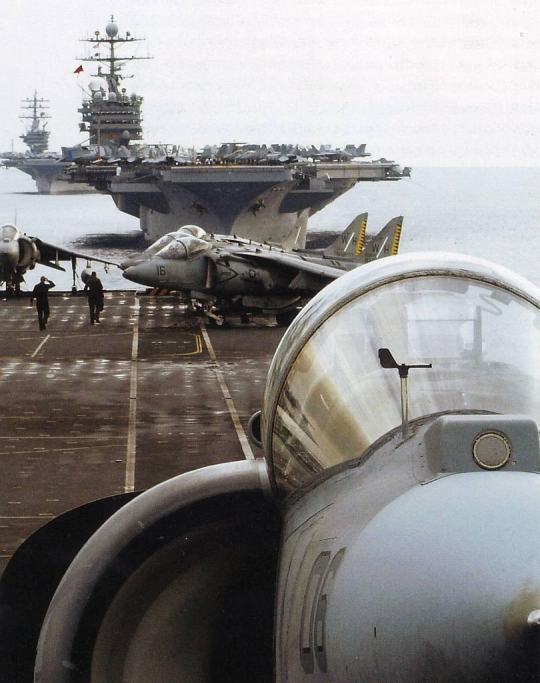
The nuclear-powered aircraft carriers USS Harry S Truman (CVN-75) and USS Dwight D. Eisenhower (CVN-69) are shown astern of the aircraft carrier HMS Illustrious in the North Atlantic off the East coast of the USA, during Operation Bold Step, 13–31 July 2007. This Joint Task Force exercise was designed to prepare the US Carrier Strike Group, based on Harry S. Truman, for deployment to the Middle East. The group consisted of the guided missile destroyer USS Winston S. Churchill (DDG-81), the guided missile cruiser USS Hue City (CG-66), the guided missile destroyer USS Oscar Austin [(DDG-79)], the nuclear-powered attack submarine USS Montpelier (SSN-765) and the Royal Navy destroyer HMS Manchester (D95). USS Dwight D Eisenhower led the second Carrier Battle Group in the exercise, whilst HMS Illustrious led the third group, which consisted of the guided missile cruisers USS Monterey (CG-61) and USS San Jacinto (CG-56), two guided missile frigates USS Nicholas [(FFG-47)] and USS Simpson [(FFG-56)], and the guided missile destroyer USS Carney (DDG-64). During the two-week exercise Illustrious embarked sixteen USMC AV-8B Harrier Strike aircraft belonging to US Marine Strike Squadron 542 and 200 US Marine personnel.
30 notes
·
View notes
Text
USS Maryland (BB-46)

Maryland was a Colorado-class battleship commissioned in 1921. Following her commissioning, Maryland undertook an East Coast shakedown cruise. Shortly thereafter, Maryland was made flagship of Admiral Hilary P. Jones. Maryland found herself in great demand for special occasions. She appeared at Annapolis, Maryland, for the 1922 United States Naval Academy graduation and at Boston, Massachusetts, for the anniversary of the battle of Bunker Hill and the Fourth of July.
From 18 August to 25 September, she paid her first visit to a foreign port transporting Secretary of State Charles Evans Hughes to Rio de Janeiro for Brazil's Centennial Exposition. The next year, after fleet exercises off the Panama Canal Zone, Maryland transited the canal in the latter part of June to join the battle fleet stationed on the west coast. She continued to be a flagship until 1923 when the flag was shifted to Pennsylvania.
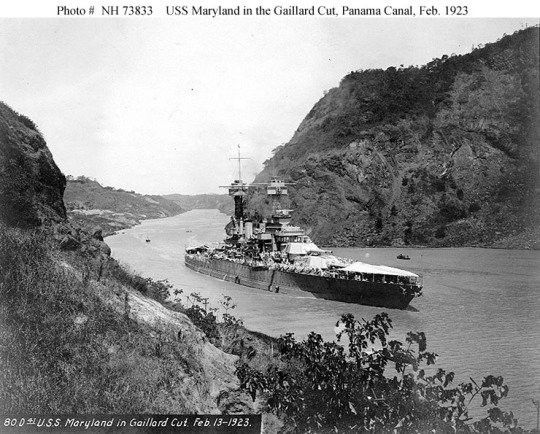
She made another voyage to a foreign port in 1925, this time to Australia and New Zealand. Several years later, in 1928, she transported President-elect Herbert Hoover on the Pacific leg of his tour of Latin America. She was overhauled in 1928–1929, and the eight 3-inch anti-aircraft guns were replaced by eight 5-inch/25 cal guns. Throughout these years and the 1930s, she served as a mainstay of fleet readiness through tireless training operations. She conducted numerous patrols in the 1930s.
In 1940, Maryland and the other battleships of the battle force changed their bases of operations to Pearl Harbor. She was present at Battleship Row along Ford Island during the Japanese attack on 7 December 1941.
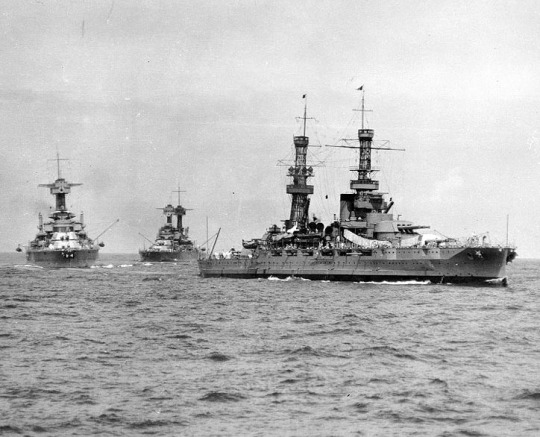
On the morning of 7 December, Maryland was moored along Ford Island, with Oklahoma to port, connected by lines and a gangway. To her fore was California, while Tennessee and West Virginia were astern. Further aft were Nevada and Arizona. The seven battleships, in what is now known as "Battleship Row," had recently returned from maneuvers. Many of Maryland's crew were preparing for shore leave at 09:00 or eating breakfast when the Japanese attack began. As the first Japanese aircraft appeared and explosions rocked the outboard battleships, Maryland's bugler blew general quarters.
Seaman Leslie Short—addressing Christmas cards near his machine gun—brought the first of his ship's guns into play, shooting down one of two torpedo bombers that had just released against Oklahoma. Inboard of Oklahoma, and thus protected from the initial torpedo attack, Maryland managed to bring all her antiaircraft (AA) batteries into action. The devastating initial attack sank Oklahoma, and she capsized quickly, with many of her surviving men climbing aboard Maryland to assist her with anti-aircraft defenses.

Maryland was struck by two armor-piercing bombs which detonated low on her hull. The first struck the forecastle awning and made a hole about 12 ft (3.7 m) by 20 ft (6.1 m). The second exploded after entering the hull at the 22 ft (6.7 m) water level at Frame 10. The latter hit caused flooding and increased the draft forward by 5 ft (1.5 m). Maryland continued to fire and, after the attack, sent firefighting parties to assist her compatriots, especially attempting to rescue survivors from the capsized Oklahoma. The men continued to muster the AA defenses in case the Japanese returned to attack. In all, two officers and two men were killed in the attack.

The Japanese erroneously announced that Maryland had been sunk, but on 30 December, the damaged ship entered Puget Sound Navy Yard for repairs just behind Tennessee. Two of the original twelve 5 -inch/51 cal guns were removed and the 5-inch/25 cal guns were replaced by an equal number of 5-inch/38 cal dual purpose guns. Over the course of the next two months, she was repaired and overhauled, receiving new fighting equipment. Repairs were complete on 26 February 1942. She then underwent a series of shakedown cruises to West Coast ports and the Christmas Islands. She was sent back into action in June 1942, the first ship damaged at Pearl Harbor to return to duty.

During the important Battle of Midway, Maryland played a supporting role. Like the other older battleships, she was not fast enough to accompany the aircraft carriers, so she operated with a backup fleet protecting the West Coast. Maryland stood by on security, awaiting call from other ships if she was needed, until the end of the battle. At the end of the action around Midway, Maryland was sent to San Francisco.
Thereafter, Maryland engaged in almost constant training exercises with Battleship Division 2, Battleship Division 3, and Battleship Division 4 until 1 August, when she returned to Pearl Harbor for repairs, her first time in the harbor since the Japanese attack. She departed Pearl Harbor in early November with Colorado, bound for the forward area. On 12 November, the pig mascot King Neptune came aboard Maryland to initiate her "pollywogs" for the line-crossing ceremony. Maryland steamed for the Fiji Islands where she patrolled against Japanese incursion. The two battleships acted as sentinels to guard against Japanese advance to prevent Japanese forces from threatening Australia. During this duty, the two battleships conducted frequent sweeps for Japanese forces.
In early 1943, with the success of the Solomon Islands campaign, Allied forces went on the offensive. In February 1943, Maryland and Colorado moved to New Hebrides, operating off of Efate.[11] Intense heat there proved difficult and unpleasant for the crew. She then moved to Espiritu Santo to guard against Japanese incursion, but heat and heavy rains plagued this tour of duty.[10] Maryland and Colorado stood out of Aore Island Harbor in August. During a five-week overhaul at Pearl Harbor's shipyard, several 40 millimetres (1.6 in) AA guns were installed on the top decks and foremast as protection against anticipated Japanese air raids in future operations.

Departing the Hawaiian Islands on 20 October 1943 for the South Pacific, Maryland became flagship for Rear Admiral Harry W. Hill's V Amphibious Force and Southern Attack Force in the Gilbert Islands Invasion. Also aboard her were Major General Julian C. Smith, commander of 2nd Marine Division, General "Howling Mad" Smith, commander of the Marine landing forces, and Colonel Evans Carlson, commander of Carlson's Raiders. Maryland returned to Efate Island staging area, where she joined a large task force preparing for an assault on Tarawa.
The battle of Tarawa commenced on 20 November. In her first offensive action of the war, Maryland's guns opened fire at 05:00, destroying a shore battery with five salvos on the southwestern point of Betio Island in the Tarawa Atoll. At 06:00 she commenced a scheduled shore bombardment to soften up Japanese defenses ahead of the landings. Maryland moved closer to shore to attract Japanese fire and locate artillery emplacements, in the process raking Japanese gun emplacements, control stations, pillboxes and any Japanese installations she could spot. At 09:00 as Marine landing forces encountered heavy Japanese resistance and began taking casualties to emplaced crossfire, Maryland provided covering fire to eliminate several Japanese machine gun nests. Her scouting plane then began to cover the progress of the Marines' assault, with Maryland providing artillery support. The plane was damaged and pilot wounded in this action.
After three days of covering the offensive on Betio Island, she moved to Apamama Island to guard Marine landings there. Marines met with only light resistance from 30 Japanese soldiers there, and two prisoners were brought to Maryland. On 7 December, Maryland left Apamama Island for Pearl Harbor. After a brief stopover there, Maryland left for San Francisco for repairs.

Maryland steamed from San Pedro, California on 13 January 1944, rendezvoused with Task Force 53 at Lahaina Roads for two days of loading ammunition, refueling, and provisioning ahead of a new operation supporting the Marshall Islands campaign. On 30 January 1944, she moved to support landings on Roi Island, along with Santa Fe, Biloxi, and Indianapolis, which formed the Northern Support Group of TF 35.
In the predawn hours of 31 January, the ships began a bombardment of Kwajalein Atoll, the opening moves of the battle of Kwajalein. Maryland destroyed numerous Japanese stationary guns and pillboxes. In the course of the battle, she fired so much that she split the liners in the guns of Turret No. 1, putting it out of action for the rest of the day. On 1 February, she continued her attack on Japanese positions as the U.S. landing forces advanced. She became the flagship for Admiral Connally for the next two weeks, resupplying and refueling many of the smaller ships in the operation until she departed with a task unit of carriers and destroyers on 15 February 1944, steaming for Bremerton Navy Yard, where she underwent another overhaul, with her guns being replaced.

Two months later, Maryland sailed westward on 5 May, joining Task Force 52 headed for Saipan. Vice Admiral Richmond K. Turner allotted TF 52 three days to soften up the island's defenses ahead of the assault. Firing commenced at 05:45 on 14 June. They quickly destroyed two coastal guns, then began bombarding Garapan, destroying ammunition dumps, gun positions, small boats, storage tanks, blockhouses and buildings. She then turned her guns to Tanapag, leveling it in heavy bombardment. The invasion commenced 15 June, and Maryland provided fire support for the landing forces.
The Japanese attempted to counter the battleships through the air. On 18 June, the ship's guns shot down their first Japanese aircraft, but on 22 June, a Mitsubishi G4M3 "Betty" medium bomber flew low over the still-contested Saipan hills and found Maryland and Pennsylvania. The Japanese plane dropped a torpedo, opening a large hole in Maryland's starboard bow. The attack caused light casualties, and in 15 minutes she was underway for Eniwetok, and from there she steamed for the repair yards at Pearl Harbor (in reverse the whole time so as not to do further damage to her bow), escorted by two destroyers. Two men were killed in the attack.

With an around-the-clock effort by the shipyard workers, Maryland was repaired in 34 days, departing on 13 August. She then embarked for the Solomon Islands with a large task force, anchoring in Purvis Bay off Florida Island for two weeks before steaming for the Palau Islands on 6 September. She then joined Rear Admiral Jesse B. Oldendorf's Western Fire Support Group. Firing first on 12 September to cover minesweeping operations and underwater demolition teams at the opening of the Battle of Peleliu, Maryland again conducted shore bombardment supporting the landing craft as they approached the beaches on 15 September. Four days later, organized resistance collapsed, permitting the fire support ships to retire to the Admiralty Islands at the end of the month.
Maryland steamed for Seeadler Harbor, Manus where she was assigned to the 7th Fleet under Admiral Kinkaid. The fleet sortied 12 October, and Maryland joined Task Group 77.2, which was the gunfire and covering force for the invasion of Leyte. She, along with four other battleships and numerous cruisers and destroyers, steamed into Leyte Gulf on the morning of 18 October. Maryland took position between Red and White Beaches and began bombarding them ahead of the invasion, which began at 10:00 20 October. Securing the beaches quickly, Maryland then took up a sentinel position in Leyte Gulf to guard the beaches against Japanese counterattack by sea.
For the next several days, Japanese forces launched air raids to counter the incursion. These included the first widespread use of the kamikaze suicide attack. Several days later, U.S. submarines in the South China Sea spotted two Japanese forces on approach: five battleships steaming toward San Bernardino Strait, and another force of four Japanese carriers in northern Luzon.
On 24 October, Maryland, West Virginia, Mississippi, Tennessee, California, and Pennsylvania sailed to the southern end of Leyte Gulf to protect Surigao Strait with several cruisers, destroyers, and PT Boats. Early on 25 October, during the Battle of Surigao Strait, Japanese battleships Fusō and Yamashiro, with their screens, led the Japanese advance into the Strait. At 03:55, the waiting Americans ships launched an ambush of the two Japanese battleships, pounding them with torpedoes and main guns. Torpedoes from the destroyers sunk Fusō. Continued attacks by the task force also claimed Yamashiro. A few of the remaining Japanese ships then fled to the Mindanao Sea, pursued by Allied aircraft.
Following the victory, Maryland patrolled the southern approaches to Surigao Strait until 29 October; she then steamed for the Admiralty Isles for brief replenishment and resumed patrol duty around Leyte on 16 November, protecting the landing forces from continued Japanese air attacks. On 29 November, during another Japanese air attack, a kamikaze aircraft surprised and struck Maryland. The aircraft crashed into Maryland between Turrets No. 1 and 2, piercing the forecastle, main, and armored decks and blowing a hole in the 4-inch steel, causing extensive damage and starting fires. In all, 31 men were killed and 30 wounded in the attack, and the medical department was destroyed but still functional.
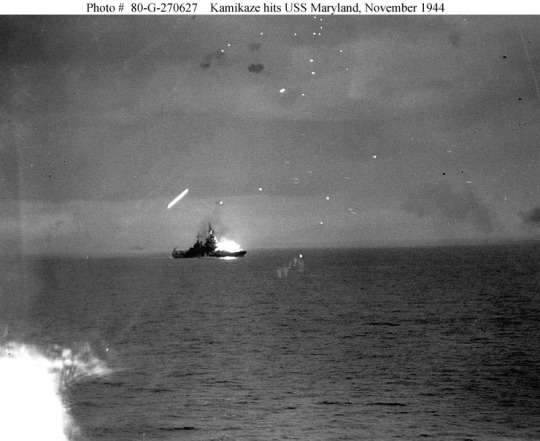
The battleship continued her patrols until relieved on 2 December, when she sailed with two heavily damaged destroyers for repairs. She reached Pearl Harbor on 18 December, and was extensively repaired and refitted over the next couple of months.
After refresher training, Maryland headed for the western Pacific on 4 March 1945, arriving Ulithi on 16 March. There she joined the 5th Fleet and Rear Admiral Morton Deyo's Task Force 54 (TF 54), which was preparing for the invasion of Okinawa. The fleet departed on 21 March, bound for Okinawa.
Maryland was assigned targets on the southern coast of Okinawa to support a diversionary landing, which would distract Japanese forces away from the main landing on the west coast. Japanese forces responded with several air raids, with two of Maryland's radar picket destroyers being struck by kamikaze planes, with Luce sinking. On 3 April, she was moved to the west coast invasion beaches to assist Minneapolis in destroying several shore batteries. Following the land invasion, she remained with the support force off Bolo Point providing artillery support for the invading troops.

Maryland continued fire support duty until 7 April, when she steamed north to intercept a Japanese surface force with TF 54. The Japanese ships, including the Yamato, came under constant U.S. air attacks that day, and planes of the Fast Carrier Task Force sank six of the 10 ships in the force. At dusk, a kamikaze loaded with a 551 lb (250 kg) bomb crashed the top of Turret No. 3 from starboard. The explosion wiped out the 20 mm mounts and caused a large fire. The 20mm ammunition ignited from the heat, causing further casualties. In all, 10 were killed, 37 injured and 6 missing following this attack. Maryland remained on station for the next week and continued her artillery support mission through several more air raids. Turret No. 3, damaged but usable, remained silent for the remainder of this mission.
On 14 April, Maryland left the firing line at Okinawa and escorted several retiring transports. They steamed via the Mariana Islands and Guam to Pearl Harbor, and she reached the Puget Sound Navy Yard at Bremerton on 7 May for extensive overhaul. All of her 5 in guns were removed and replaced by sixteen 5 inch/38 cal guns in new twin mounts. Turret No. 3 was repaired and the crew quarters were improved. She completed repairs in August, leaving for tests and training runs just as Japan surrendered, ending the war.
She next entered Operation Magic Carpet fleet. During the remaining months of 1945, Maryland made five voyages between the west coast and Pearl Harbor, returning more than 8,000 servicemen to the United States.
Arriving at Seattle, Washington on 17 December, Maryland completed her Operation Magic Carpet duty. She entered Puget Sound Naval Shipyard on 15 April 1946, and was placed in commission in inactive reserve on 16 July. She was decommissioned at Bremerton on 3 April 1947, and remained there as a unit of the Pacific Reserve Fleet. Maryland was sold for scrapping to Learner Company of Oakland, California on 8 July 1959.
On 2 June 1961, Governor of Maryland J. Millard Tawes, dedicated a monument to the memory of Maryland and her men. Built of granite and bronze and incorporating the bell of "Fighting Mary", this monument is located on the grounds of the State House in Annapolis.
174 notes
·
View notes
Photo
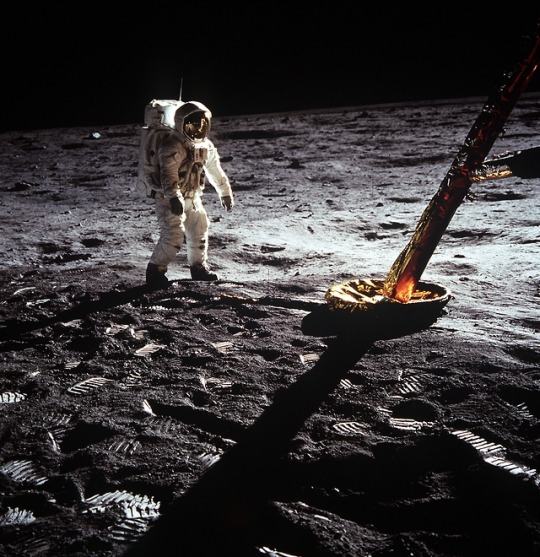

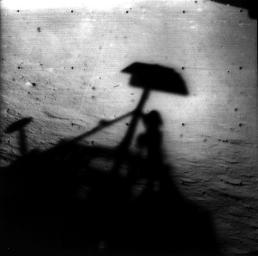
The Jet Propulsion Laboratory's Apollo Connection That "giant leap" from 50 years ago - when Neil Armstrong became the first human to step onto the surface of the Moon - is imprinted on several generations. Some savor that day as a treasured memory, while for others, it's an inspirational chapter in history books. While NASA's Jet Propulsion Laboratory in Pasadena, California, has long been associated with robotic missions rather than ones involving astronauts, the Lab helped pave the way for the historic Apollo missions that took humans to the Moon. Here are three contributions by JPL: Hard Landings JPL was tasked in the 1960s with designing and building a series of impact probes, called Rangers, designed to fly to the Moon and crash into it, and return images to Earth. The Lab's successful Mariner 2 mission to Venus was a modified Ranger spacecraft, but when it came to the Moon, "The Rangers ran into lots of trouble, with several failed missions," said JPL Historian Erik Conway. Seven became the lucky number for the program, when Ranger 7 collided with the Moon on July 31,1964. (In a lighthearted moment, team members attributed the success to the fact that someone in mission control was eating peanuts. Since then, JPL teams have broken out peanuts for luck during milestone events, such as Mars landings and spacecraft orbit insertions.) The program ended in 1965, after Rangers 8 and 9 also proved successful. One lesson learned from the Ranger missions was that the Moon has rocks, lots of them - a reality that would prove challenging for future missions to land astronauts on the surface. A Softer Approach Instead of building in-house, JPL developed the next generation of lunar spacecraft, the Surveyors, under a systems management contract with Hughes Aircraft. "These were intended to land a very large, broad variety of scientific instruments," Conway said. The wrinkle was that Surveyor development began before the upper Centaur stage of the launch vehicle was ready, so engineers didn't know how much payload it could hoist. Because of that, Surveyor 1 carried only a TV camera - no scientific instruments. And its official mission requirements were simple by today's standards, according to Conway: "They had to survive the mid-course correction, land, and send back good engineering data." A third goal - not a requirement - was to send back television pictures. Surveyor 1 succeeded on all three counts, landing successfully on June 2, 1966, and beaming back thousands of pictures. Once the engineers learned the capabilities and capacity of the launch vehicle, they added instruments to subsequent landers. Five of the seven Surveyors were successful, and the missions answered a key question that would face the Apollo program: "How strong is the lunar surface? There had been some fear that the landers would merely sink into dust, and that would be bad," Conway said. He added that while a Soviet probe had already demonstrated that the fear was probably groundless, the Surveyor series used engineering instruments that "really nailed that down." In the lull between the Surveyors and the Apollo program, there was a plan to have a version of a Surveyor tote a lunar rover, but the Surveyor program was cancelled before that rover flew. The rover hung around JPL for a long time, eventually becoming a prototype for the Mars rover program. A Parallel Network for Space Talk NASA'S human spaceflight program, based at what is now Johnson Space Center in Houston, originated at Langley Research Center in Virginia via an organization called the Space Task Group. It was set up before Apollo for the Mercury program. The Mercury and Gemini programs used a ground-based tracking and communication system called the Manned Space Flight Network and run by Goddard Space Flight Center in Maryland. It could not be adapted for use outside Earth orbit, so, Conway said, "They decided to make a clone of [JPL's] Deep Space Network," an array of giant radio antennas. The Apollo program needed full-time communications support, and JPL had its own missions, so DSN engineers helped design and operate a "parallel network." After the Apollo program ended, the DSN inherited the equipment. Since then, the DSN has kept the legacy alive by providing communications for a very long roll call of missions - for NASA and other space agencies. Managed by JPL, the DSN will play a central role in NASA's Artemis lunar explorations and the agency's plans for astronauts to one day go beyond the Moon to Mars. TOP IMAGE....Astronaut Edwin E. Aldrin Jr., lunar module pilot, walks on the surface of the Moon near a leg of the Lunar Module during the Apollo 11 extravehicular activity (EVA) on July 20, 1969. Astronaut Neil A. Armstrong, Apollo 11 commander, took this photograph with a 70mm lunar surface camera. The astronauts' bootprints are visible in the foreground. While astronauts Armstrong and Aldrin descended in the Lunar Module Eagle to explore the Sea of Tranquility region of the Moon, astronaut Michael Collins, command module pilot, remained with the Command and Service Modules Columbia in lunar orbit. CENTRE IMAGE....Ranger 7 took this image, the first picture of the Moon by a U.S. spacecraft, on 31 July 1964 at 13:09 UT (9:09 AM EDT) about 17 minutes before impacting the lunar surface. The area photographed is centered at 13 S, 10 W and covers about 360 km from top to bottom. The large crater at center right is the 108 km diameter Alphonsus. Above it is Ptolemaeus and below it Arzachel. The terminator is at the bottom right corner. Mare Nubium is at center and left. Nor this at about 11:00 at the center of the frame. The Ranger 7impact site is off the frame, to the left of the upper left corner. (Ranger 7, B001) The Ranger series of spacecraft were designed solely to take high-quality pictures of the Moon and transmit them back to Earth in real time. The images were to be used for scientific study, as well as selecting landing sites for the Apollo Moon missions. Ranger 7 was the first of the Ranger series to be entirely successful. It transmitted 4,308high-quality images over the last 17 minutes of flight, the final image having a resolution of 0.5 meter/pixel. Ranger 7 was launched July 28, 1964 and arrived at the Moon on July 31, 1964. Image Credit: NASA/JPL LOWER IMAGE....Image of Surveyor 1's shadow against the lunar surface in the late lunar afternoon, with the horizon at the upper right. Surveyor 1, the first of the Surveyor missions to make a successful soft landing, proved the spacecraft design and landing technique. In addition to transmitting over 11,000 pictures, it sent information on the bearing strength of the lunar soil, the radar reflectivity, and temperature. Surveyor 1 was launched on May 30, 1966 and landed on June 2, 1966. Image Credit: NASA/JPL
3 notes
·
View notes
Text
Headlines
Christian and Muslim growth
(Pew) There are about 2.3 billion Christians in the world and 1.8 billion Muslims. That gap is expected to narrow by 2060, when Pew Research Center projects there will be 3 billion Christians and nearly 3 billion Muslims.
Airline will cancel 90 flights a day through June
(GMA) American Airlines is extending flight cancellations into early June as its fleet of Boeing 737 Max aircraft remain grounded pending additional information from the FAA.
US Homeland Security Secretary resigns
(Reuters) U.S. Homeland Security Secretary Kirstjen Nielsen resigned on Sunday, amid a surge in the number of migrants at the border with Mexico. Nielsen had been DHS secretary since December 2017. Her departure had been repeatedly rumored over the past year, particularly after a wave of anger over the administration’s 2018 family separation policy at the border with Mexico and most recently as U.S. border officials estimated that 100,000 migrants were apprehended at the southern border in March, the highest level in a decade. And Nielsen isn’t the only one leaving. Ralph Alles, head of the Secret Service and a 35-year veteran of the Marines, will also depart.
U.S. Judge Halts Trump Policy of Returning Asylum Seekers to Mexico
(Reuters) A U.S. judge on Monday halted the Trump administration’s policy of sending some asylum seekers back across the southern border to wait out their cases in Mexico, stopping a program the government planned to expand to stem a recent flood of migrants.
Midwest floods and California gas prices
(Reuters) The March floods that punished the U.S. Midwest have roiled the ethanol industry, hammering prices and trapping barrels in the country’s interior while the U.S. coasts suffer from shortages of the biofuel. Ethanol shortages are one factor pushing gasoline prices in Los Angeles and Southern California to the highest in the nation and they could top $4 a gallon for the first time since 2014, according to tracking firm GasBuddy.
Trump administration cancels deal allowing Major League Baseball to sign Cuban players
(Washington Post) The administration said the Cuban Baseball Federation was part of the Cuban government, so the deal, signed in December, was illegal. The announcement came days after the federation released the names of 34 players it said were eligible to sign with Major League Baseball.
Theresa May to Ask Merkel and Macron for Brexit Delay
(Reuters) British Prime Minister Theresa May will meet German Chancellor Angela Merkel and French President Emmanuel Macron on Tuesday to argue for a Brexit delay while her ministers hold crisis talks with the opposition to try to break the deadlock in London.
UK plan steps up global crackdown on social media
(AP) The U.K. unveiled plans on Monday to vastly increase government oversight of social media companies, with a first of its kind watchdog that could fine executives or even ban companies if they fail to block content such as terrorist propaganda or images of child abuse.
Turkish Election Board Rejects Recount Call in 31 Istanbul Districts
(Reuters) Turkey’s High Election Board has rejected a request by President Tayyip Erdogan’s AK Party to recount all votes in 31 Istanbul districts, a board member said on Tuesday, but the party vowed to challenge the decision.
Modi’s Alliance to Win Slim Majority in Indian Election, Poll Shows
(Reuters) Indian Prime Minister Narendra Modi’s ruling alliance will win a thin majority in a general election that starts on Thursday, an average of four opinion polls showed, with a focus on national security appearing to trump concerns over jobs and farm prices.
Kazakhstan to Hold Early Presidential Election on June 9
(Reuters) Kazakhstan’s interim president, Kassym-Jomart Tokayev, called a snap presidential election on Tuesday, citing the need to eliminate political uncertainty in the oil-rich Central Asian nation.
Hong Kong Occupy Leaders Found Guilty for Role in Mass Rallies
(Reuters) A Hong Kong court found leaders of the 2014 “Occupy” civil disobedience movement guilty on Tuesday of public nuisance charges during the mass protests, in a landmark verdict that comes as the China-ruled city’s freedoms come under strain.
U.S. Designates Elite Iranian Force as Terrorist Organization
(Reuters) The United States designated Iran’s elite Revolutionary Guard Corps a foreign terrorist organization, President Donald Trump said on Monday, marking the first time Washington has formally labelled another country’s military a terrorist group. (NYT) Top Pentagon and C.I.A. officials oppose the designation, which they argue would allow hard-line Iranian officials to justify deadly operations against Americans overseas, especially Special Operations units and paramilitary units working under the C.I.A.
Suicide Bombers Attack Syrian Army Post, Several Dead: Media
(Reuters) Suicide bombers disguised as farmers struck an army position in western Syria on Tuesday in an attack that killed three people and all the militants, state-run media said.
Israelis Go to Polls to Decide on Netanyahu’s Record Reign
(Reuters) Israelis began voting in an election on Tuesday that could hand conservative Prime Minister Benjamin Netanyahu a record fifth term or see him dethroned by an ex-general who has pledged clean government and social cohesion.
Tripoli fighting
(Reuters) Eastern Libyan forces are seeking to reach the center of Tripoli, as their easy advance through the desert hits a trickier urban phase. Deaths and displacements are mounting in the renewed civil war in Libya, leaving the West aghast at the threat to its peace plan. The fighting threatens to disrupt oil and gas supplies, trigger more migration to Europe, and allow Islamist militants to exploit the chaos.
2 notes
·
View notes
